Comparison & Reviews
Comparison & Reviews
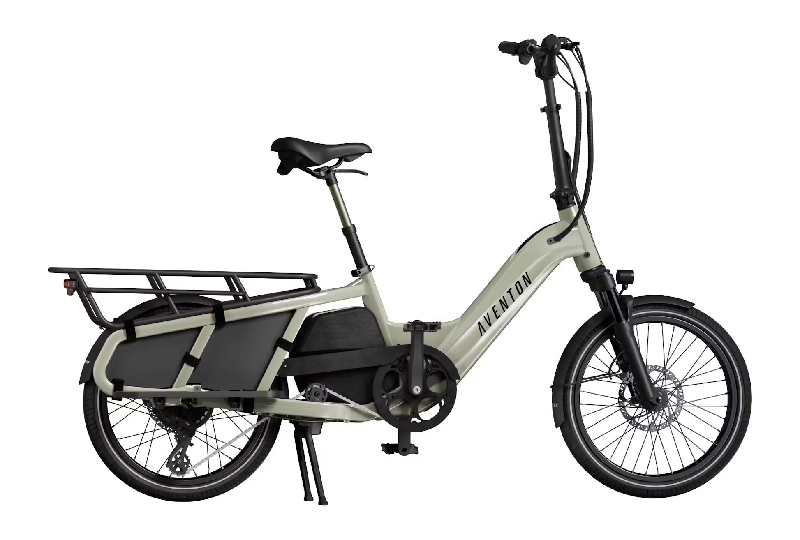
Have you noticed more families cruising by on e-bikes lately? The rise of electric bikes designed for family outings and hauling cargo is changing how we think about getting around. These bikes offer a practical, eco-friendly, and fun way to transport kids, groceries, and even bulky loads — all without breaking a sweat.
A key feature that sets these e-bikes apart is long-range capability. Whether you’re planning a day trip with the kids or need to haul heavy cargo across town, having an e-bike that can go the distance makes all the difference.
What Makes a Great Family or Cargo E-Bike?
When shopping for the best e-bikes for families or cargo, keep an eye out for these essentials:
- Power: Look for motors with enough torque to handle heavy loads and hills without strain.
- Range: A strong battery that can cover 40+ miles on a single charge keeps adventures going longer.
- Comfort: Adjustable seats, stable frames, and ergonomic handlebars mean everyone rides happy.
- Durability: Heavy-duty frames and reliable components ensure your bike can handle the extra weight day after day.
Pro Tip: Think About Your Typical Ride
Estimate how far and how often you’ll ride fully loaded. This helps you pick the right battery size and motor power without overspending.
What You’ll Learn in This Guide
This article will walk you through everything you need to know about family and cargo e-bikes in 2025. From key features to watch for, top models worth considering, and tips to help you make the smartest purchase — it’s all here.
Whether you’re new to e-bikes or upgrading to a more powerful ride, you’ll gain the confidence to choose the right bike that fits your lifestyle and budget.
Ready to Ride?
E-bikes aren’t just a cool gadget — they’re a game-changer for families and anyone who needs reliable cargo transport. Find the perfect family or cargo e-bike today and experience the freedom and fun that comes with electric power.
Why Choose a Long-Range Family and Cargo E-Bike?
Learn why long-range family and cargo e-bikes are a smart choice in 2025. Explore their benefits, key differences from standard e-bikes, and practical uses for everyday life.
Go Farther with Less Hassle
Tired of stopping to recharge your e-bike battery mid-ride? Long-range family and cargo e-bikes give you the freedom to take longer trips and rely less on frequent charging. This means more time enjoying the ride and less time plugged in.
What Sets Family and Cargo E-Bikes Apart?
Not all e-bikes are created equal. Family and cargo models are built to handle heavier loads and tougher conditions. Here’s how they differ:
- Stronger Motors: Designed to deliver extra torque for carrying kids, groceries, or bulky items up hills with ease.
- Reinforced Frames: Built tough to support more weight without compromising stability or comfort.
- Bigger Batteries: Larger capacity batteries provide longer range, so you can cover more miles in a single charge.
Practical Uses for Long-Range Family and Cargo E-Bikes
These bikes aren’t just for fun—they’re practical tools that can replace cars for many everyday tasks, like:
- Grocery Runs: Haul all your shopping without worrying about storage space.
- School Trips: Safely transport kids with built-in child seats or cargo boxes.
- Hauling Bulky Items: Move larger packages, tools, or picnic gear easily.
- Weekend Adventures: Enjoy family outings or errands without range anxiety.
Pro Tip: Match Battery Size to Your Routine
If you typically ride 20 miles a day fully loaded, choose a battery with at least double that range for peace of mind and unexpected detours.
Ready to Upgrade Your Ride?
Choosing a long-range family or cargo e-bike means less stress, more freedom, and practical solutions for your daily needs. Explore your options and find the best e-bike for your family today.
Key Features to Look For in Long-Range Family and Cargo E-Bikes
Discover the essential features of long-range family and cargo e-bikes in 2025, including battery capacity, motor power, frame design, comfort, cargo options, and safety.
Battery Capacity & Range: Power Your Adventures
When it comes to long-range e-bikes, the battery is the heart of your ride. Battery capacity is measured in watt-hours (Wh), which tells you how much energy the battery stores. The higher the Wh, the longer the bike can go before needing a recharge.
Voltage also plays a role in performance, with higher voltage often meaning better power delivery. In real-world terms, expect a well-equipped family or cargo e-bike to cover 40 miles or more on a single charge, depending on load and terrain.
Motor Power & Torque: Handling Heavy Loads with Ease
For family and cargo e-bikes, motor torque is just as important as raw power. Torque measures the twisting force the motor can apply—critical for climbing hills and accelerating smoothly when carrying kids or bulky cargo.
Look for motors with high torque ratings (usually measured in Newton-meters or Nm) to ensure your bike handles steep inclines and heavy weight without strain.
Frame Design & Build Quality: Stability Meets Strength
A sturdy frame is a must for safely carrying passengers or cargo. Family and cargo e-bikes feature reinforced frames that provide extra durability and stability. Many models use step-through frames to make mounting and dismounting easier, especially when loaded.
Safety features like strong welds and secure attachment points for seats or racks add peace of mind on every ride.
Comfort & Ergonomics: Keep Everyone Happy
Long rides and heavy loads demand comfort. Look for e-bikes with:
- Adjustable seats to fit different riders
- Suspension systems that soften bumps and rough terrain
- Ergonomic handlebars designed for relaxed posture
These features reduce fatigue, making your trips more enjoyable for both adults and kids.
Cargo Capacity & Accessories: Ready for Anything
A great family or cargo e-bike comes equipped to carry what you need. Key features include:
- Integrated racks strong enough for heavy loads
- Child seats or cargo boxes designed for safety and convenience
- Panniers and baskets to organize groceries or gear
Modular accessories let you customize your bike for your unique lifestyle.
Safety Features: Ride with Confidence
Carrying heavier loads means stopping safely is critical. Look for:
- Powerful brakes, often hydraulic disc brakes, that perform well under weight
- Bright integrated lights and reflectors for visibility in low light
- Sturdy tires with good grip for stable handling
These features keep you safe on busy streets and quiet trails alike.
Pro Tip: Test Ride with Your Typical Load
Bring some cargo or have your child on board during test rides to feel how the bike handles real-world weight and comfort.
Ready to Find Your Perfect E-Bike?
Knowing what to look for in battery, motor, frame, comfort, cargo options, and safety will help you pick the best e-bike for your family’s needs. Explore models with confidence and enjoy the ride!
Top Long-Range Family and Cargo E-Bikes (2025)
Explore the best long-range family and cargo e-bikes of 2025. Detailed reviews by category help you find the perfect electric bike for urban use, heavy hauling, kids transport, and more.
Best for Urban Use
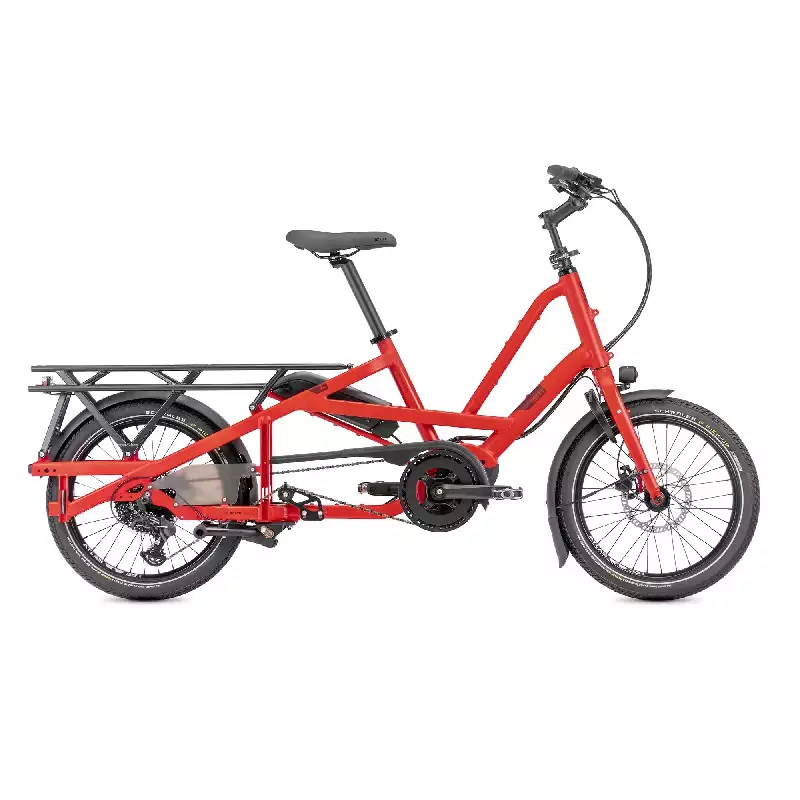
Tern Quick Haul Long D9
- Range & Specs: Up to 60 miles, Bosch Cargo Line motor with 85Nm torque, 500Wh battery.
- Cargo & Family Features: Supports up to 419 lbs total weight, fits two kids, compact design for city spaces, versatile accessory options for school runs or groceries.
- Pros: High weight capacity, customizable, quality construction.
- Cons: No suspension, pricier than basic models.
- Ideal Use: Daily commuting, quick errands, urban families wanting to ditch the car.
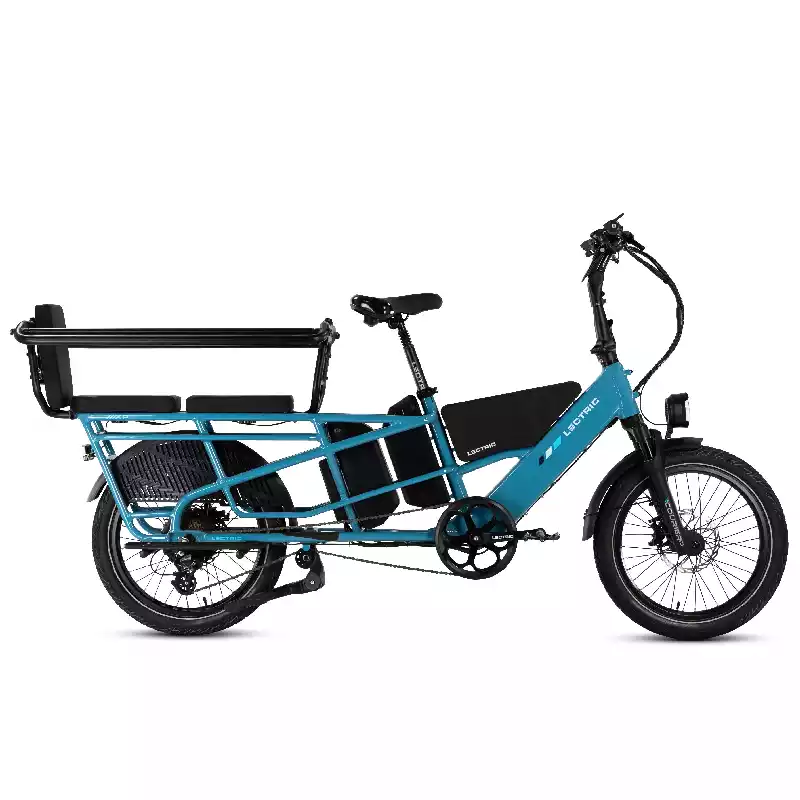
Best for Heavy Cargo
Lectric XPedition 2.0
- Range & Specs: Up to 75 miles with optional dual batteries (48V, 14Ah each), 750W rear hub motor, top speed 28 mph.
- Cargo & Family Features: 450 lbs payload capacity, spacious enough for multiple kids or large cargo, budget-friendly at $1,399.
- Pros: Excellent value, heavy load capability, optional dual battery for extended range.
- Cons: Heavier bike, fewer premium touches.
- Ideal Use: Large grocery hauls, delivery runs, families needing long daily trips.
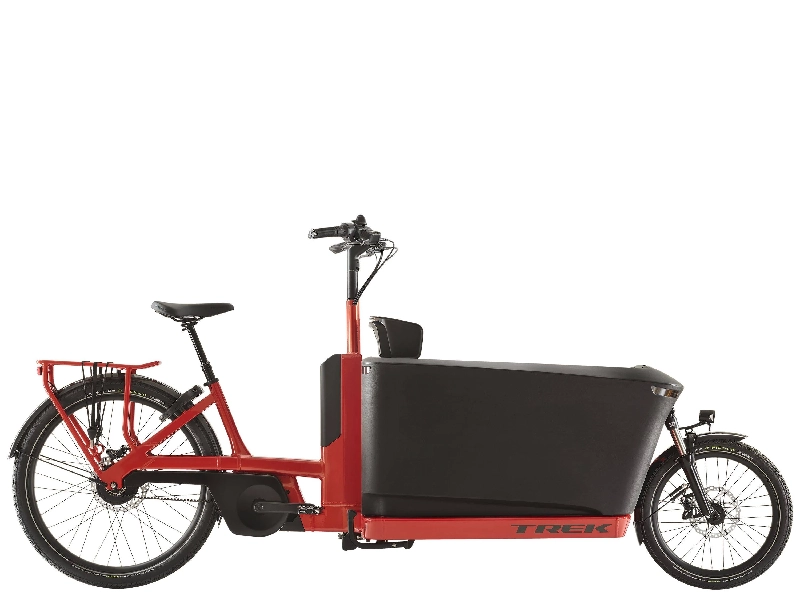
Best for Kids Transport
Trek Fetch+ 4
- Range & Specs: Bosch BES3 Cargo Drive motor, belt drive system, Class 1 e-bike.
- Cargo & Family Features: Seats up to 4 kids with included child seats and front cargo box; weather protection accessories available.
- Pros: Superb safety features, smooth ride, designed for multiple passengers.
- Cons: Heavy at 165 lbs, large footprint requiring storage space, higher price point.
- Ideal Use: Family carpools, replacing a minivan for kid transport.

Best Budget Long-Range Family Cargo Bike
Aventon Abound LR
- Range & Specs: 30+ miles real-world range, 750W hub motor, 720Wh battery.
- Cargo & Family Features: 440 lbs weight limit, rear rack for child seat or cargo, front and rear lights, suspension for comfort.
- Pros: Good value, comfortable ride, accessible price.
- Cons: Small display, controls might feel cramped for larger hands.
- Ideal Use: Suburban errands, family outings, first-time cargo e-bike buyers.
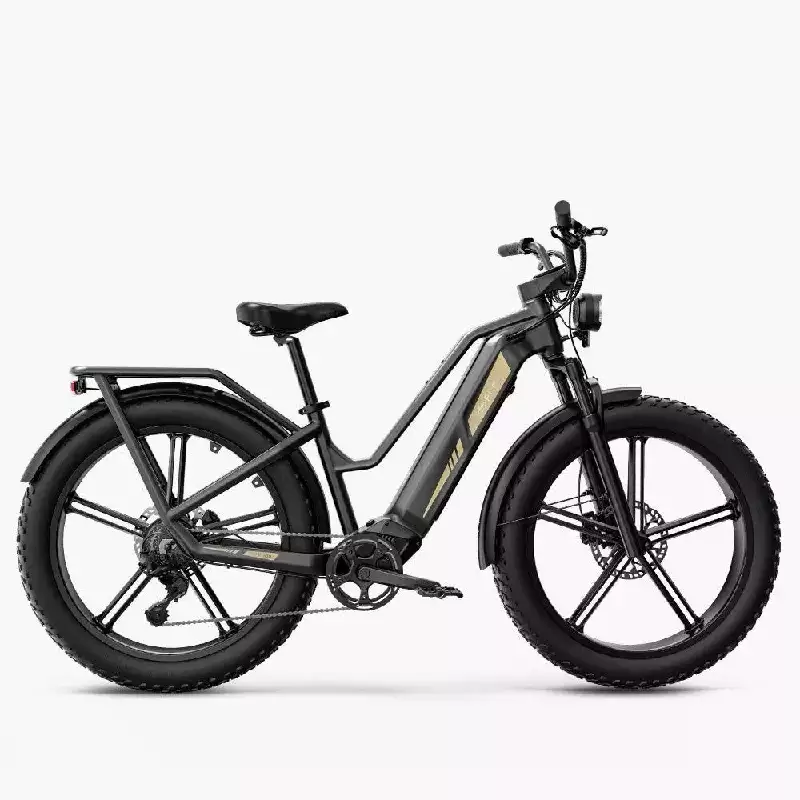
Best Ultra-Long Range Cargo E-Bike
Fiido Titan
- Range & Specs: Up to 250 miles with three batteries, 750W motor, 440 lbs cargo capacity.
- Cargo & Family Features: Heavy-duty frame, fat tires for varied terrain, rugged design.
- Pros: Exceptional range, very durable, great for heavy loads.
- Cons: Very heavy (83 lbs), more than needed for city rides, additional cost for extra batteries.
- Ideal Use: Long-distance trips, camping, rural or farm use.
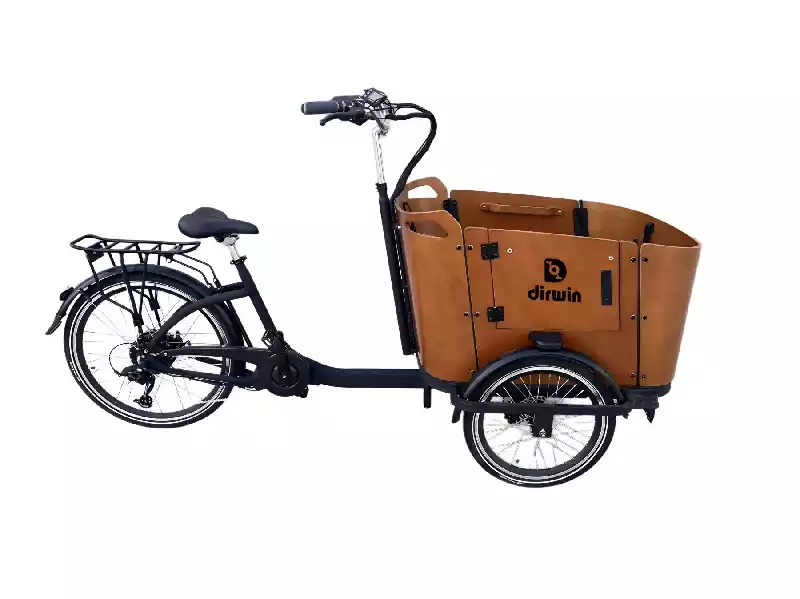
Best Trike for Maximum Safety
Dirwin Caravan Cargo E-Bike
- Range & Specs: Up to 60 miles, 350W motor, 16Ah lithium battery.
- Cargo & Family Features: Three-wheel stability, rear compartment with seatbelts for 2-4 passengers, waterproof cover included.
- Pros: Maximum safety and stability, roomy cargo and passenger space.
- Cons: Bulkier, lower top speed.
- Ideal Use: Families with young kids or elderly, short city trips prioritizing safety.
Pro Tip: Choose Based on Your Priorities
If you need maximum range and heavy hauling, the Lectric XPedition 2.0 or Fiido Titan stand out. For kid-focused transport, Trek Fetch+ 4 leads the pack. Newcomers or budget shoppers will appreciate the Aventon Abound LR. Safety-first families should consider the Dirwin Caravan trike.
Ready to Find Your Perfect Family or Cargo E-Bike?
With options designed for every lifestyle and budget, there’s never been a better time to upgrade to a long-range family or cargo e-bike. Explore these top picks and get ready to enjoy effortless rides with your loved ones.
Tips for Maximizing Range on Family and Cargo E-Bikes
Learn how to get the most range from your family or cargo e-bike with simple riding habits, maintenance tips, load management, and smart use of assist modes.
How Can You Extend Your E-Bike’s Battery Life on Every Ride?
Maximizing your e-bike’s range means more fun, longer trips, and less time charging. Whether you’re hauling kids or groceries, smart riding and good upkeep can stretch your battery life and keep your adventures going strong.
Efficient Riding Habits: Smart Speed and Assist Use
- Control your speed: Riding at a steady, moderate pace saves energy. High speeds drain the battery faster.
- Use pedal assist wisely: Choose eco or low assist modes whenever possible to reduce power draw while still getting help on hills or tough sections.
- Avoid sudden acceleration: Smooth starts use less battery than quick bursts of speed.
Regular Maintenance: Keep Your Bike Running Smoothly
- Check tire pressure: Properly inflated tires reduce rolling resistance, helping your bike move easier and save energy.
- Battery care: Charge regularly but avoid letting the battery drain completely. Store batteries in cool, dry places.
- Brake and drivetrain checks: Well-maintained brakes and clean chains reduce drag and improve efficiency.
Load Management and Distribution: Balance Matters
- Pack smart: Distribute cargo evenly to avoid extra effort from imbalance.
- Avoid overloading: Stick to your bike’s weight limits to prevent unnecessary strain on the motor and battery.
- Remove unnecessary weight: Carry only what you need to keep rides lighter and more efficient.
Pro Tip: Plan Your Route for Efficiency
Choose flatter routes or paths with fewer stops to conserve battery power and enjoy a smoother ride.
Ready to Ride Further and Smarter?
With these simple tips, you can boost your family or cargo e-bike’s range and enjoy more hassle-free trips. Start practicing today and experience how far your e-bike can really take you!
Accessories to Enhance Your Family and Cargo E-Bike Experience
Discover must-have accessories for family and cargo e-bikes in 2025, including child seats, weather covers, cargo bags, and smart security tools to upgrade your ride.
Make Every Ride Safer and More Comfortable
Want to get the most out of your family or cargo e-bike? The right accessories can transform your rides—making them safer, more convenient, and enjoyable for everyone on board.
Child Seats and Safety Harnesses: Secure Your Little Passengers
- Child seats: Designed specifically for e-bikes, these offer sturdy support and comfort for your kids.
- Safety harnesses: Keep young riders secure and confident, especially on busy streets or bumpy rides.
- Easy to install and remove, these accessories make family trips worry-free.
Weather Protection Covers: Ride Rain or Shine
- Waterproof covers: Shield your cargo or kids from rain and wind.
- Canopies and rain guards: Provide extra protection for little ones during unpredictable weather.
- Lightweight and durable, these covers keep your rides comfortable whatever the forecast.
Cargo Bags and Panniers: Organize Your Essentials
- Cargo bags: Spacious and designed to fit on racks or baskets for groceries, school supplies, or work gear.
- Panniers: Side-mounted bags that balance your load and free up space.
- Easy to attach and remove, these make packing simple and efficient.
GPS Tracking and Smart Locks: Protect Your Investment
- GPS trackers: Keep tabs on your e-bike’s location, helping prevent theft or loss.
- Smart locks: Use Bluetooth or app-based locking systems for quick, keyless security.
- These tech-savvy accessories add peace of mind, especially in busy urban areas.
Pro Tip: Customize Based on Your Lifestyle
Choose accessories that fit your daily needs—whether it’s extra cargo space for groceries or weather protection for kids on rainy days.
Ready to Upgrade Your Ride?
Adding the right accessories can make your family and cargo e-bike even more practical and fun. Explore options today and enjoy every ride to the fullest!
Frequently Asked Questions (FAQs)
Get clear answers to common questions about long-range family and cargo e-bikes, including range, safety, maintenance, and customization options.
How Far Can a Long-Range Cargo E-Bike Typically Go on a Single Charge?
Most long-range cargo e-bikes can travel 40 to 75 miles on a single charge, depending on factors like battery size, terrain, rider weight, and cargo load. Some models with dual batteries can even push beyond 100 miles. Real-world range varies, but choosing a bike with a larger battery and efficient motor helps maximize your trip length.
Are These E-Bikes Safe for Carrying Kids?
Yes! Family and cargo e-bikes designed for kids come with built-in safety features like sturdy child seats, secure harnesses, and stable frames. Many models also include protective weather covers and reliable brakes made to handle extra weight. Always follow the manufacturer’s weight and age guidelines for passengers and ensure proper helmet use.
What Maintenance Is Required for Long-Term Durability?
Regular maintenance keeps your e-bike running smoothly and extends its life. Key tasks include:
- Checking tire pressure and inflating as needed
- Charging the battery properly and storing it in a cool, dry place
- Cleaning and lubricating the chain and drivetrain
- Inspecting brakes and cables for wear
- Scheduling professional tune-ups annually or as recommended
Can I Customize My Cargo E-Bike for Specific Needs?
Absolutely! Many cargo e-bikes offer modular accessories like child seats, cargo racks, panniers, and weather protection. Some brands let you swap batteries or upgrade motors. Customizing your bike lets you tailor it perfectly for family outings, grocery runs, or work errands.
Pro Tip: Always Check Compatibility Before Adding Accessories
Make sure any add-ons match your e-bike’s frame and weight limits for safety and performance.
Ready to Ride with Confidence?
Understanding how long-range family and cargo e-bikes work helps you choose the best model and keep it in top shape. With the right info and gear, you’re set for many happy miles ahead!
Final Thoughts
The Right E-Bike Can Transform the Way You Travel
Long-range family and cargo e-bikes offer more than just eco-friendly transportation—they bring flexibility, fun, and freedom to your everyday life. With powerful motors, smart accessories, and enough range to keep up with your busy schedule, these bikes are a true game changer for families, commuters, and adventurers alike.
Match Your Bike to Your Life
Whether you're hauling kids to school, loading up with groceries, or exploring weekend trails, there's an electric cargo bike that fits your needs. Think about your daily routes, storage space, rider height, and preferred features. And if you’re unsure, a few test rides can go a long way in helping you feel confident.
Pro Tip: Don’t Forget the Accessories
Upgrading with child seats, rain covers, and cargo bags can make your e-bike even more useful and comfortable year-round.
Ready to Ride?
Now that you’ve seen the best long-range options and learned what features to look for, it’s time to explore your favorites and take the next step. Check out the models we reviewed, compare specs, and start planning your next adventure—your perfect e-bike is waiting.
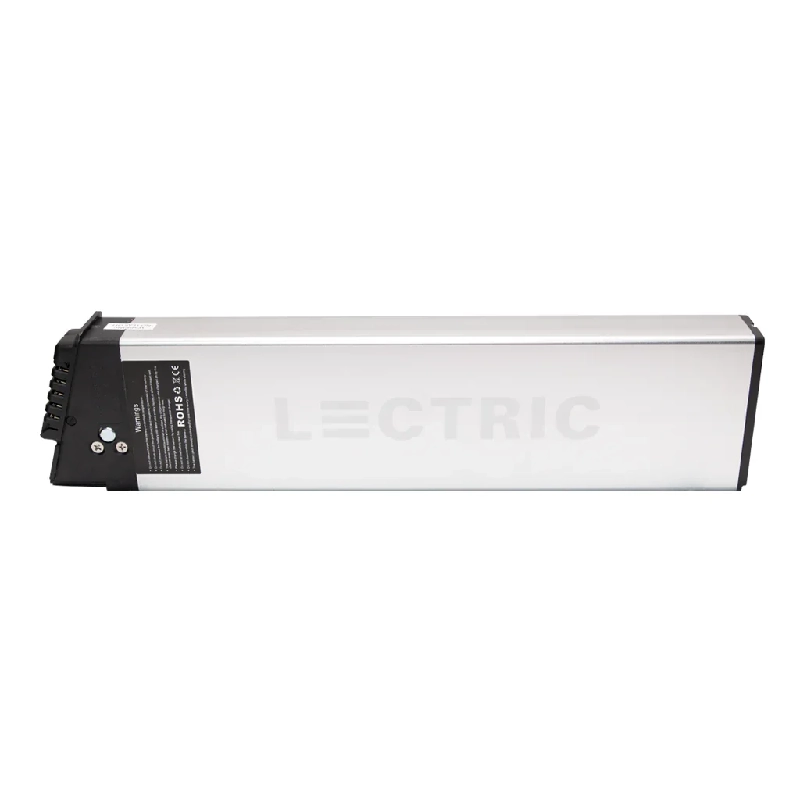
If there’s one thing every serious e-bike rider craves, it’s range. Whether you're commuting across town, tackling long scenic routes, or just want peace of mind on the trails, how far your battery takes you makes a huge difference.
In this guide, we’ll break down the key factors that determine real-world battery performance—like watt-hours, voltage, and battery chemistry—plus highlight some of the best long-range e-bikes available today. You’ll also get simple, practical tips to make your battery last longer and perform better.
Let’s clear up the confusion around range numbers and help you ride farther, smarter, and with confidence.
What Really Impacts E-Bike Battery Range
Battery Capacity: Watt-Hours (Wh) Matter Most
Think of watt-hours (Wh) as your battery’s fuel tank. The higher the number, the longer your ride—in theory.
- A 500Wh battery typically gives 25–45 miles, depending on terrain and assist level.
- A 750Wh battery can go 45–70 miles, great for longer commutes or hilly rides.
- A 1000Wh battery? You're looking at up to 100+ miles with conservative riding.
Pro Tip: To estimate real range, divide Wh by 20 for throttle-heavy rides or by 15 for moderate pedal assist.
Voltage and Motor Efficiency
Voltage is like horsepower—it impacts how hard your motor can push.
- 36V systems are common in casual commuter e-bikes.
- 48V gives a stronger boost, especially uphill or with cargo.
- 52V is found in high-performance and off-road models.
A high-voltage battery paired with an efficient motor can extend range by reducing the strain on each ride.
Battery Chemistry: It’s Not All the Same
Most e-bikes today use lithium-ion batteries, which offer solid performance, but there are variations:
- Li-ion (Lithium-ion): Lightweight, high capacity, decent lifespan.
- LiFePO4 (Lithium iron phosphate): More stable and longer-lasting, but heavier.
- NiMH and lead-acid: Outdated and rarely used in quality e-bikes.
Look for cells from trusted names like Samsung, LG, or Panasonic for reliability.
Other Things That Affect Your Range
Even with a top-tier battery, range depends on how and where you ride. Here’s what can shrink (or boost) your mileage:
- Rider weight and cargo load
- Tire pressure and tread
- Assist level (eco vs turbo)
- Headwinds and hills
- Start-stop city riding vs steady cruising
Pro Tip: Keep your tires inflated and ride in lower assist modes to maximize range without sacrificing comfort.
Top Long-Range E-Bikes Worth Checking Out
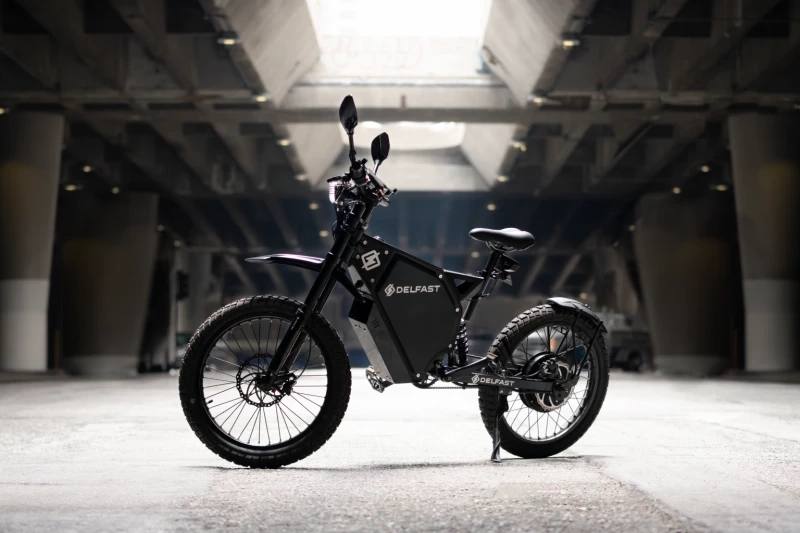
Delfast Top 3.0 – Up to 200 Miles
An industry leader for extreme distance. Equipped with a 3000Wh battery and 72V system, it’s practically a motorcycle with pedals.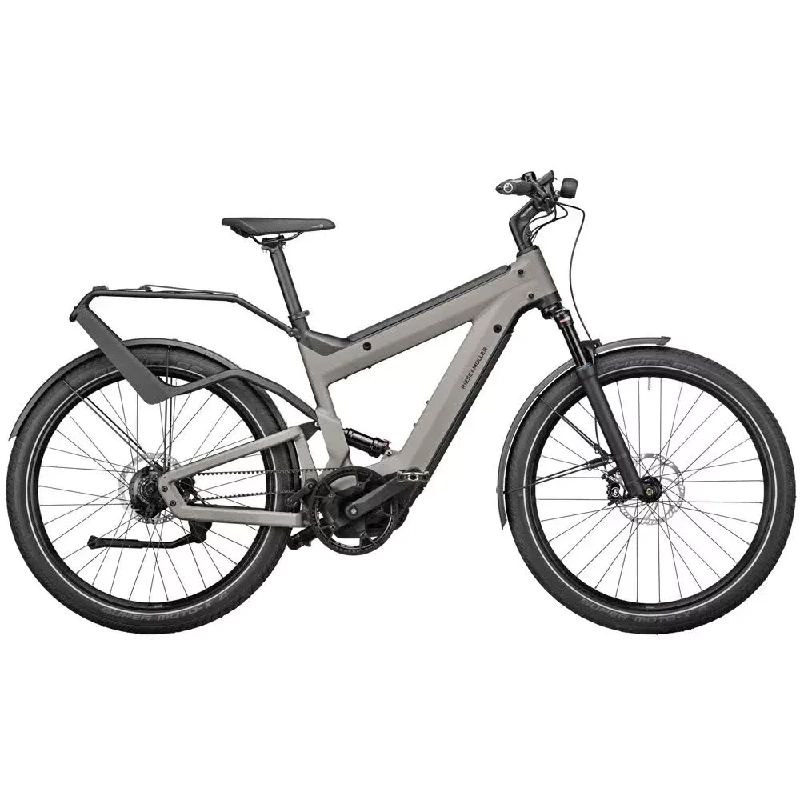
Riese & Müller Superdelite GT – Dual Battery System
Dual 625Wh Bosch PowerTube batteries offer up to 100 miles. Ideal for riders who want premium tech and full-suspension comfort.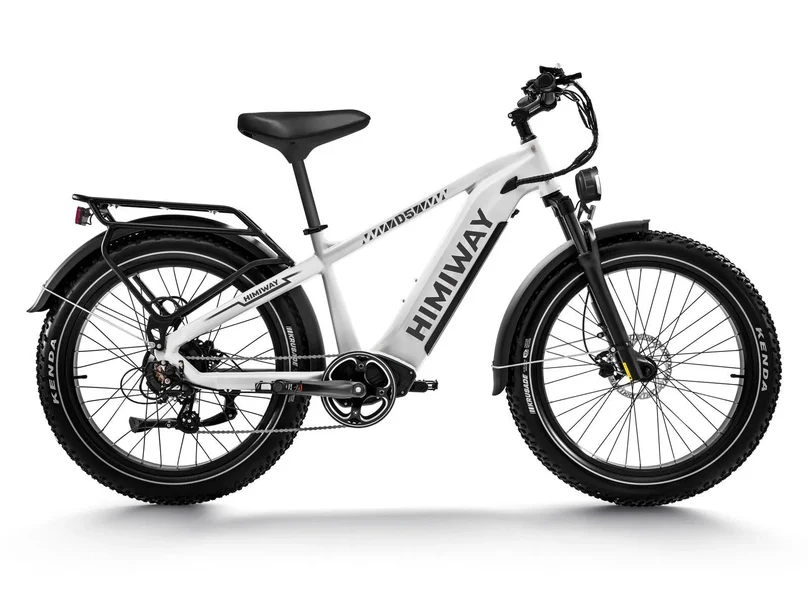
Himiway Zebra – Budget-Friendly Long Range
With a 960Wh battery and fat tires, this model can hit up to 80 miles per charge—at a surprisingly affordable price point.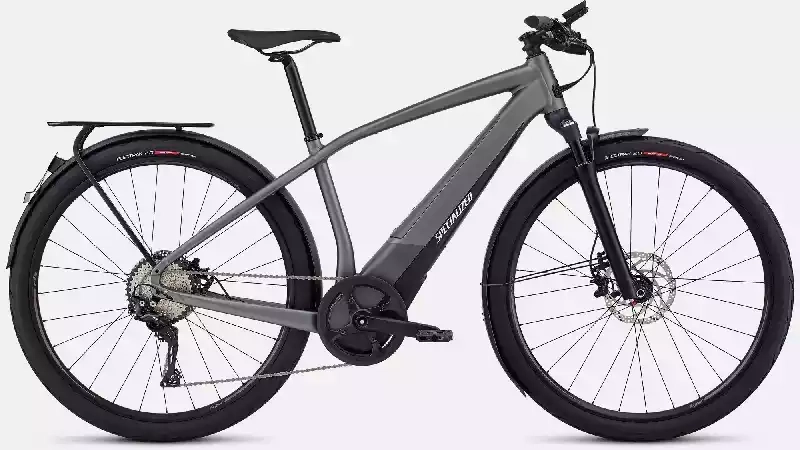
Specialized Turbo Vado 5.0 – Premium Commuter
A sleek 710Wh battery paired with smart range management gives 70–90 miles of urban and suburban freedom.
Dual Battery Systems: Are They Worth It?
Some high-end bikes now come with dual battery setups, letting you double your range without swapping packs mid-ride.
Benefits:
- Ride farther without range anxiety
- Balanced weight distribution on premium frames
- Less frequent charging
Consider this if you tour, ride hilly terrain, or just love long rides with zero interruptions.
Can You Upgrade Your Battery?
Yes—but do it carefully. Many e-bike brands sell aftermarket or extended-range batteries, but compatibility is key.
Look for:
- Matching voltage and connector type
- Same brand or approved third-party seller
- Whether the controller and motor can handle more juice
Skipping these steps could void your warranty or even damage your bike.
Battery Care Tips to Extend Lifespan
A long-range battery isn’t just about size—it’s about how you treat it.
Charging Do’s and Don’ts
- Don’t charge to 100% daily—stop at 80–90% when possible.
- Avoid full discharges—try not to drop below 10%.
- Use the original charger to prevent overheating or short-circuiting.
Storage and Handling
- Store at 40–70% charge if not riding for a few weeks.
- Keep in a cool, dry place—extreme heat kills battery cells.
- Never leave it in a hot car or freezing garage.
Basic Maintenance
- Clean contacts gently with a dry cloth
- Inspect regularly for swelling or damage
- Don’t hose it down—use a damp rag and be careful near ports
What to Look for in a Long-Range Battery Setup
When choosing your next e-bike or upgrade, keep these points in mind:
- Minimum 600Wh for moderate-range needs, 750Wh+ for long rides
- Look for trusted cells (Samsung, LG, Panasonic)
- Prefer removable batteries for easy charging
- Consider total weight—bigger battery = heavier ride
- Check the warranty—some batteries come with 1–2 year guarantees
Battery range can make or break your e-bike experience. The good news? With the right knowledge, setup, and care, you can ride farther and worry less.
Whether you’re shopping for a powerful commuter, an all-day adventurer, or just want to get the most out of your current setup—battery matters most.
Ready to ride longer? Start by checking your current battery’s specs or exploring long-range e-bikes that fit your style and budget.
What Determines E-Bike Battery Range?
Not all e-bike batteries are created equal—and just looking at the advertised “miles per charge” won’t give you the full picture. Real-world range depends on several technical factors, from battery size to motor voltage, plus how you actually ride.
Let’s break it all down in plain English so you can confidently choose the best long-range e-bike or upgrade your current setup.
Battery Capacity (Watt-hours or Wh)
Watt-hours (Wh) are the #1 number to look for when comparing e-bike batteries. It tells you how much energy the battery stores—and more Wh generally means more miles.
- Formula: Voltage × Amp-hours = Watt-hours
- 500Wh: Common on mid-range commuter bikes. Expect 25–45 miles with mixed usage.
- 750Wh: A solid upgrade for longer range. You’ll get up to 60 miles on pedal assist.
- 1000Wh+: Great for touring or hilly terrain—often 70–100+ miles per charge.
Pro Tip: Divide the battery’s Wh rating by 20 for throttle-heavy rides or by 15 for mixed pedal assist to estimate real-world range.
Voltage and Motor Compatibility
Voltage plays a big role in how much power your e-bike delivers—especially when climbing hills or accelerating with cargo.
- 36V systems: Ideal for flat terrain and casual riding
- 48V systems: More torque and better suited for hills or heavier riders
- 52V systems: High-performance setups often used in mountain or fat-tire e-bikes
Pairing your voltage correctly with the motor and controller ensures smoother performance and helps preserve battery life. Too much voltage for the motor can cause overheating, while too little can make your ride feel underpowered.
Pro Tip: Look for e-bikes that match a 48V or 52V battery with a 500W+ motor for the best balance of speed, efficiency, and hill-climbing ability.
Battery Chemistry
You might see fancy terms like “Li-ion” or “LiFePO4” when shopping around. Here's what that really means:
- Lithium-ion (Li-ion): The most common and well-balanced choice. Lightweight, decent lifespan, and good range.
- Lithium Iron Phosphate (LiFePO4): Safer and longer-lasting (1,500–2,000 charge cycles), but usually heavier and more expensive.
- Nickel or Lead-acid: Outdated—avoid these in modern e-bikes unless you’re buying used on a budget.
Why it matters: Some chemistries handle heat better, charge faster, and last longer. That can affect how far you go—not just today, but two years from now.
Other Factors That Affect Range
Even with the best battery on the market, range can still vary wildly depending on your riding conditions. Here’s what else plays a role:
- Rider weight and cargo: Heavier loads = faster drain
- Terrain: Flat city streets preserve power; hills eat it up
- Wind resistance: Headwinds can reduce range significantly
- Assist level: Riding in turbo mode will cut your range in half
- Tire pressure and type: Under-inflated tires add rolling resistance
Pro Tip: Ride in eco or tour mode and keep tires inflated to the recommended PSI to get the most out of every charge.
Understanding how these elements work together helps you choose a bike that fits your lifestyle—and avoid the disappointment of buying a “long-range” e-bike that falls short in real life.
Coming up next: We’ll explore the top long-range e-bikes on the market and what makes them stand out.
Top Long-Range E-Bike Batteries on the Market
Looking for an e-bike that can go the distance? Some models are built with ultra-efficient systems and massive batteries that make range anxiety a thing of the past. Whether you're planning cross-city commutes or long adventure rides, these are the models worth checking out.
Models With Exceptional Range
Here are four of the best long-range e-bikes available right now—each packed with powerful battery systems and smart engineering.
- Delfast Top 3.0
This beast offers up to 200 miles per charge, making it one of the longest-range electric bikes on the market. With a 72V 48Ah battery (3456Wh), it's basically a light electric motorcycle with pedals. - Riese & Müller Superdelite GT
A premium dual-battery touring bike that delivers up to 100 miles on eco mode. Its integrated Bosch system uses two 625Wh PowerTube batteries for long-distance riding with full suspension comfort. - Himiway Zebra
A budget-friendly fat tire e-bike with a 960Wh battery that can deliver up to 80 miles on a single charge. Perfect for city cruising and light off-road adventures. - Specialized Turbo Vado 5.0
A sleek commuter bike powered by a 710Wh battery, offering 70–90 miles of range depending on rider settings and terrain. Ideal for urban riders who want power with style.
Real-world note: Manufacturer range claims are usually based on ideal conditions. Expect real-world mileage to be about 10–20% lower, depending on your ride style and environment.
Pro Tip: If you're riding in hilly areas or using high pedal assist levels often, prioritize bikes with 750Wh or larger batteries to avoid daily charging.
Dual Battery Systems
Want to ride even farther without swapping batteries mid-ride? Dual battery systems might be your answer.
How it works: Two batteries are connected in parallel, either built into the frame or mounted externally. The system draws power from one or both batteries, depending on design.
Benefits:
- Double the range without compromising performance
- Automatic switching between batteries (in most modern systems)
- Ideal for touring, delivery, or long commutes
Top bikes with dual battery options:
- Riese & Müller Superdelite
- Gazelle Ultimate C380+ Dual Battery
- BULLS Lacuba EVO E8
Who needs dual batteries?
- Riders commuting 50+ miles daily
- Adventure cyclists who ride remote trails
- People who don’t want to charge every day
Pro Tip: Check how the bike balances the battery weight—some dual battery setups can feel top-heavy if not well-designed.
Aftermarket Battery Upgrades
Already have an e-bike but want more range without buying a new one? An aftermarket battery upgrade could be your solution—but there are a few things to know before diving in.
When to upgrade:
- Your current battery no longer holds a charge
- You want longer rides without recharging
- You’ve added accessories (like a trailer or extra lights) that draw more power
Top aftermarket battery brands:
- Luna Cycle
- Grin Technologies
- Unit Pack Power (UPP) – widely compatible with budget e-bikes
- Bosch and Shimano – for OEM upgrades (brand-specific)
What to watch out for:
- Voltage and connector compatibility
- Whether your motor/controller supports larger capacity
- Battery mount and frame space
- Warranty concerns—aftermarket changes may void your e-bike’s original warranty
Pro Tip: Never upgrade to a higher voltage without checking with the manufacturer. Doing so could damage your controller or motor.
With so many high-capacity and efficient options available, it’s easier than ever to find (or build) an e-bike that meets your real-world range needs. Next, we’ll show you how to keep that battery in top shape—because the best battery is one that lasts.
Battery Care Tips to Maximize Lifespan
A high-quality e-bike battery is a big investment—so why not make it last as long as possible? With a few simple habits, you can extend your battery’s lifespan by years and avoid losing range over time.
Here’s how to charge, store, and maintain your e-bike battery the smart way.
Charging Best Practices
How (and how often) you charge your battery makes a huge difference. Most e-bike batteries are lithium-ion, which prefer partial charging rather than full cycles.
- Don’t charge to 100% every time – Stop at 80–90% if you’re not doing a long ride
- Avoid deep discharges – Try not to let the battery drop below 10%
- Use the original charger – Other chargers might overheat or damage the battery cells
Pro Tip: If your e-bike app allows it, set a charge limiter to stop at 80%. This helps preserve battery health over the long haul.
Storage Tips
Not riding for a few weeks? How you store your battery during downtime directly affects its performance later.
- Store between 40–70% charge – Fully charged or empty batteries degrade faster
- Avoid extreme heat or cold – Don’t leave your battery in a hot car or freezing shed
- Use a battery cover or case – Especially if you ride or store your e-bike outdoors
If you’re putting your bike away for the season, check the charge once a month and top it off if needed.
Pro Tip: Room temperature (around 60–70°F) is ideal for battery storage. Avoid places like attics, garages, or backseats that swing hot and cold.
Cleaning and Maintenance
Keeping your battery clean and damage-free helps prevent issues that could shorten its life—or worse, create safety risks.
- Wipe battery contacts with a dry or slightly damp cloth – Avoid moisture in ports
- Never hose down your e-bike – Water pressure can force liquid into battery seals
- Inspect regularly – Look for cracks, swelling, or discoloration around the casing
If you notice odd smells, sudden drops in range, or visible bulging, it’s time to stop riding and consult the manufacturer or your local bike shop.
Taking good care of your battery doesn’t have to be complicated—it just takes a little attention to detail. Next up, we’ll help you choose the best long-range battery setup for your riding style and goals.
Buying Tips: What to Look for in a Long-Range E-Bike Battery
Choosing the right battery can make all the difference in your e-bike experience. Whether you’re a daily commuter or weekend adventurer, knowing what to look for helps you pick a battery that matches your riding goals—and lasts for years.
Minimum Capacity to Aim For
Your battery’s capacity, measured in watt-hours (Wh), directly impacts how far you can go.
- For casual city riding or short commutes, aim for at least 400–500Wh.
- If you want longer rides or tackle hills, look for 750Wh or more.
- Touring riders or those needing maximum range should consider 1000Wh+ batteries.
Trusted Battery Cell Brands
Not all batteries are built equal. Look for batteries using cells from well-known manufacturers like:
- Samsung
- LG
- Panasonic
These brands are known for consistent quality, safety, and longevity. Batteries from unknown brands may be cheaper but often come with trade-offs in reliability.
Removable vs Integrated Designs
- Removable batteries let you charge off the bike, making it easier to top up at work or home.
- Integrated batteries offer a sleeker look and better weight distribution but usually require charging the entire bike.
If you expect to charge frequently in different locations, a removable battery is usually more practical.
Weight vs Range Trade-Offs
Bigger batteries mean more range—but also more weight.
- Heavier batteries can make your bike harder to handle, especially off-road or when lifting it.
- Consider how much range you really need versus how much extra weight you’re comfortable with.
Warranty and Brand Support
Finally, check the battery’s warranty—at least 1 year is standard, but some brands offer 2 years or more. Good customer support can save you headaches if anything goes wrong.
Pro Tip: Always register your battery with the manufacturer after purchase to activate warranty and get updates.
Picking the right battery is key to getting the most from your e-bike. With these tips, you’re ready to find a battery that powers your rides for years to come.
Ready to ride farther? Explore the best e-bikes for your needs and enjoy the freedom of extended range!
Final Thoughts
Choosing the right e-bike battery is essential to enjoy longer rides without worrying about running out of power. We’ve covered the key factors that matter most: battery size, chemistry, voltage, and proper battery care.
Remember, the best battery setup depends on your riding style and goals. Whether you’re commuting daily, exploring trails, or just cruising on weekends, selecting the right battery will make your rides smoother and more enjoyable.
Pro Tip: Don’t hesitate to research and test different models to find what suits you best. Upgrading your existing battery is also a smart way to get more freedom without buying a whole new bike.
Ready to ride farther and smarter? Dive into the world of long-range e-bikes and take your cycling adventures to the next level!
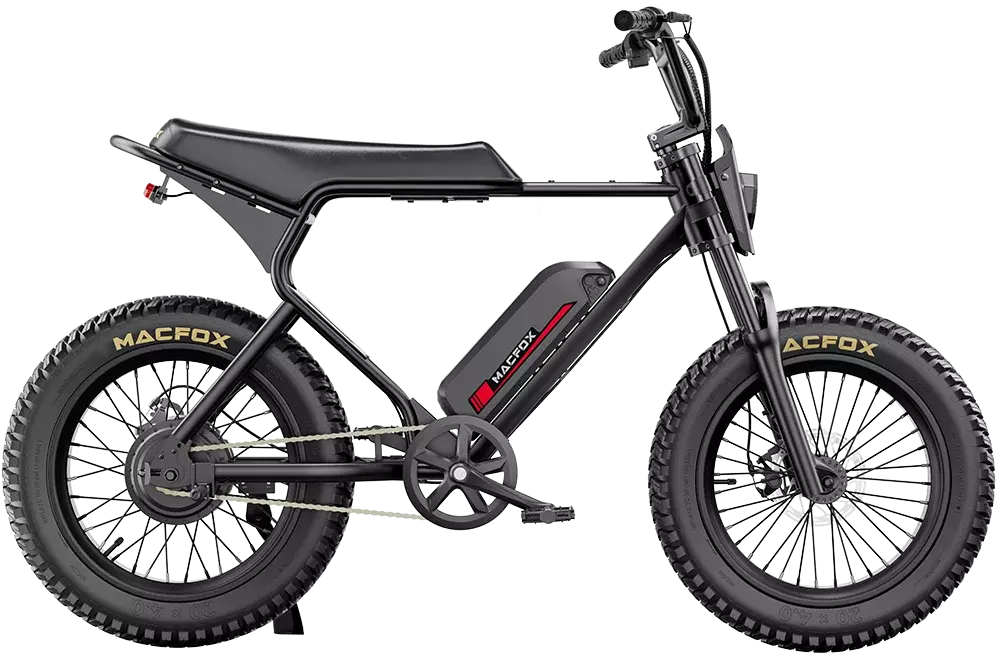
Are you thinking about getting an e-bike for your teen? Electric bikes are rapidly becoming the go-to choice for young riders thanks to their ease, speed, and fun factor. But with so many options on the market, picking the right e-bike can feel overwhelming.
Choosing the best e-bike for teens isn’t just about cool looks or speed—it’s about safety, comfort, and affordability. After all, teens need bikes that are easy to handle, reliable, and built with features designed just for them.
In this guide, you’ll discover the top 5 e-bikes for teen riders in 2025, handpicked for their safety features, budget-friendly prices, and teen-friendly design. Whether your teen is a beginner or ready for more serious rides, this review will help you find the perfect fit.
Pro Tip: Look for e-bikes with adjustable seats and handlebars—this helps the bike grow with your teen and ensures a comfortable ride every time.
Ready to find the perfect e-bike that balances fun, safety, and value? Let’s dive in!
Key Factors to Consider When Choosing an E-Bike for Teens
Picking the right e-bike for a teen is more than just finding a cool-looking ride. It’s about balancing safety, affordability, and features that make riding fun and easy. Here’s what to keep in mind:
Safety Features
Safety should always be the top priority. Look for bikes with:
- Speed limit controls to prevent teens from going too fast
- Reliable brakes, like disc brakes or regenerative braking, for smooth and quick stops
- A sturdy frame and durable design that can handle daily use and occasional bumps
- Lights and reflectors to keep riders visible during low-light conditions
Affordability
E-bikes come in a wide price range. For families on a budget, consider:
- Models priced reasonably without sacrificing essential features
- Bikes offering great value—durability and good warranty can save money in the long run
Teen-Friendly Features
Teens have unique needs, so check for:
- Adjustable seat height and handlebars so the bike fits growing riders comfortably
- A lightweight frame that’s easy to handle and maneuver
- Battery range that suits short trips, school commutes, or weekend adventures
- Simple, user-friendly controls and displays that teens can quickly learn
Legal and Age Restrictions
Before buying, be aware of:
- Local e-bike laws and age limits—some places require teens to be a certain age to ride specific types of e-bikes
- Helmet laws and safety gear recommendations to keep young riders protected on every ride
Pro Tip: Check your state or city’s regulations for e-bikes before making a purchase. Knowing the rules helps keep your teen safe and legal on the road.
Choosing an e-bike that combines these key factors will ensure your teen enjoys riding safely, comfortably, and confidently. Ready to explore the best options for 2025? Keep reading to find the top picks designed just for teen riders!
Top 5 E-Bikes for Teen Riders in 2025
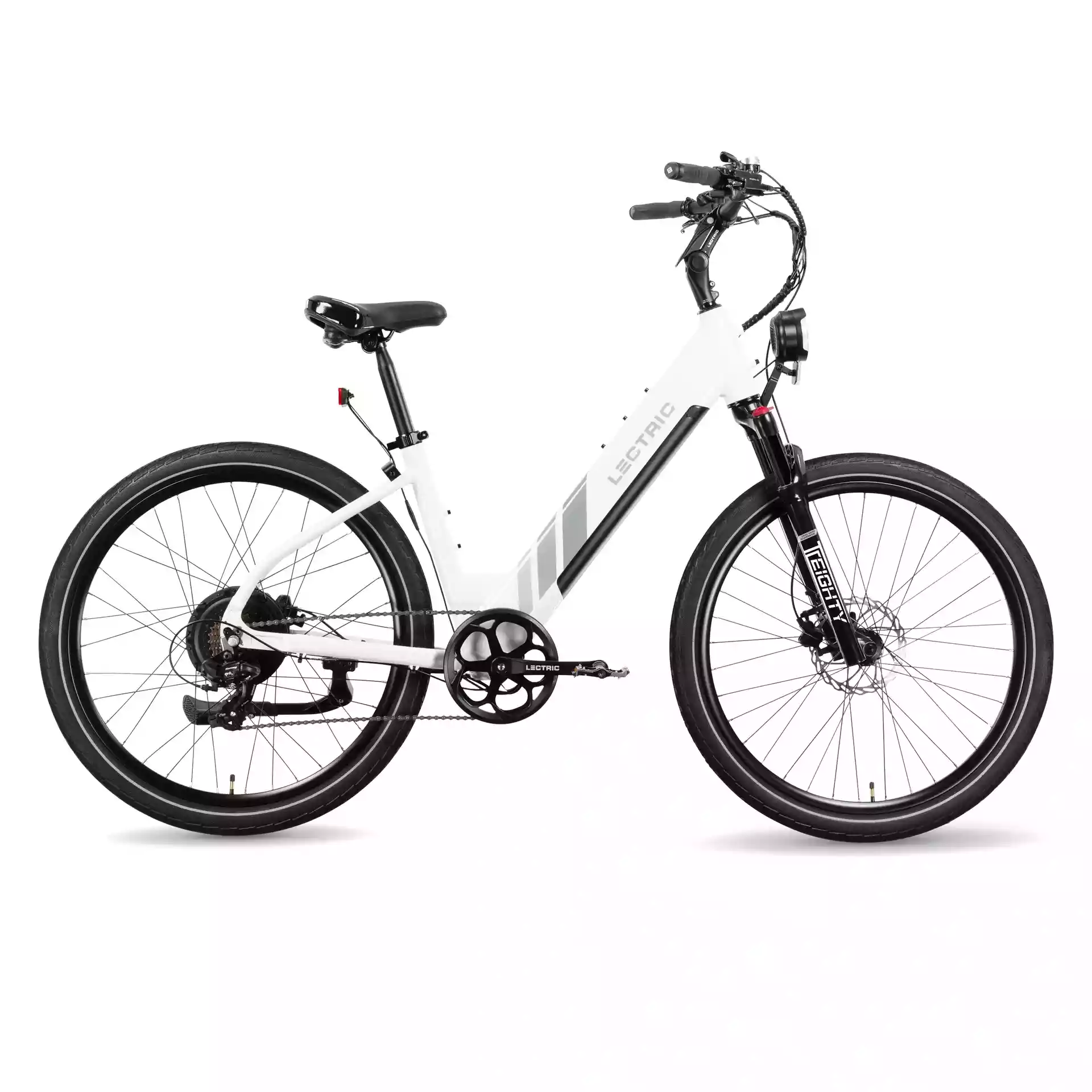
Lectric XPress 500W Step-Thru Electric Road eBike
The Lectric XPress offers a great balance of affordability and practical features, making it a perfect entry-level e-bike for teens. Priced around $1,000, it features a lightweight step-thru frame that’s easy to mount and handle.
Safety features include reliable disc brakes, multiple pedal-assist levels, and built-in speed limits to keep rides safe and controlled. The 500W motor provides enough power for daily commutes, with a typical range of 20–40 miles.
Comfort and convenience come from its slim, compact design, ideal for school runs and neighborhood cruising.
Pros: Affordable, easy handling, teen-friendly design
Cons: Range and ride smoothness are basic compared to premium models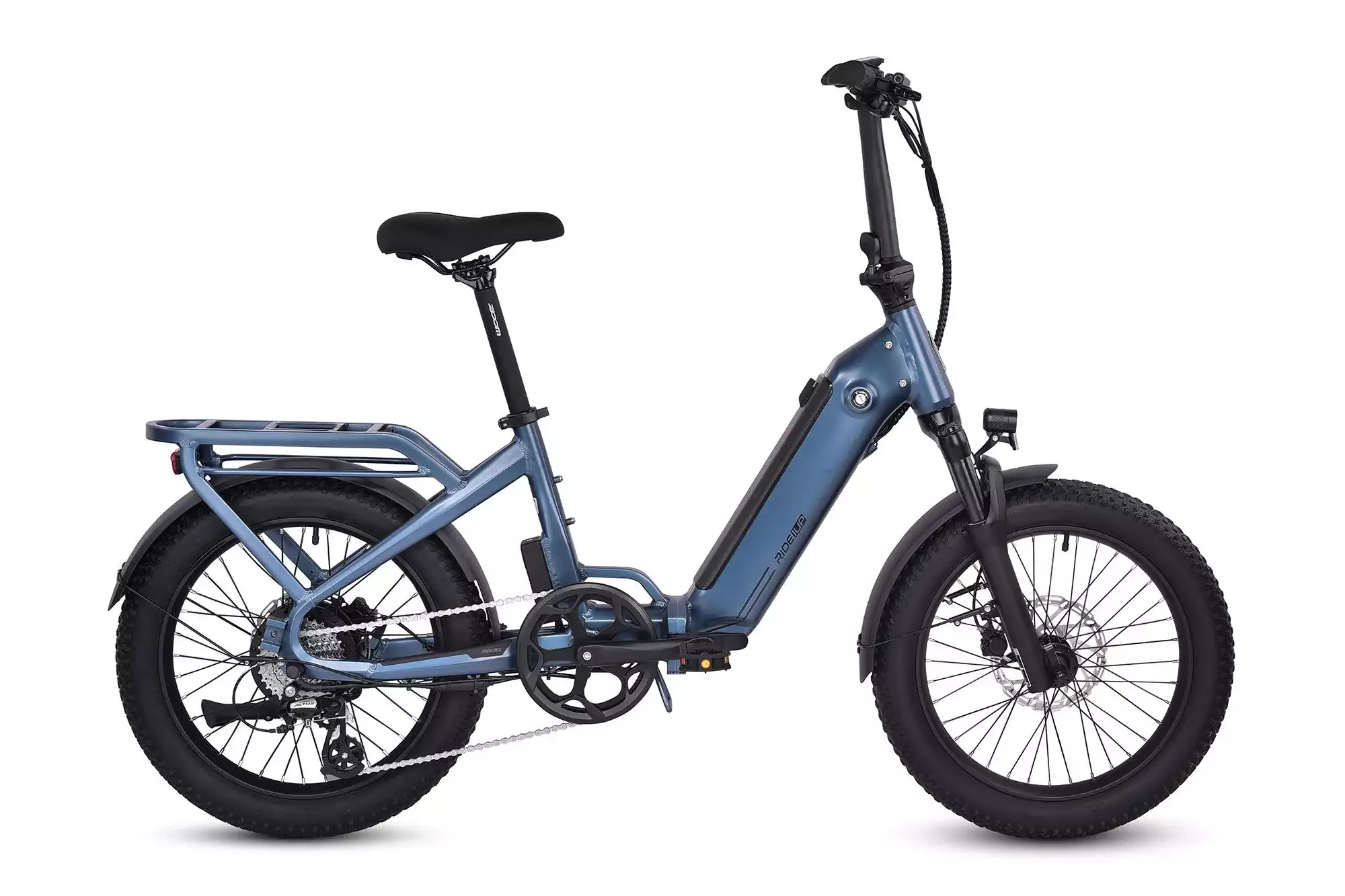
Ride1Up Portola
Perfect for teens needing portability, the Ride1Up Portola is a folding e-bike starting at about $1,095. Its compact design folds quickly for easy storage in tight spaces.
It features hydraulic disc brakes for strong stopping power and a 750W motor with battery options providing 20–45 miles of range. A 20 mph top speed balances fun and safety.
The bike includes a rear rack, great for carrying backpacks or groceries.
Pros: Portable, solid brakes, good carrying capacity
Cons: Slightly heavy for a folding bike (around 62 lbs)
Engwe X20
For teens who love adventure, the Engwe X20 is a compact but powerful choice priced near $999. Its fat tires and triple shock absorbers provide stability and comfort on rough terrain.
Powered by a 750W motor, it can reach speeds up to 31 mph (check local laws) and offers an impressive 62-mile range per charge.
It folds down for storage and features grippy tires perfect for wet or gravel roads.
Pros: Stable, long range, fun off-road capability
Cons: Speed might require adjustment for younger riders
Macfox X1S
The Macfox X1S is a stylish and versatile e-bike around $999, designed for city riding and commuting. It includes mechanical disc brakes and integrated front and rear LED lights for enhanced visibility.
Its 500W motor (750W peak) offers a 38–76 mile range and a 25 mph top speed. Comfort features include a PU memory foam seat and fat tires suited to multiple surfaces.
The easy-to-read LCD display helps teens keep track of speed and battery.
Pros: Comfortable, long range, strong safety features
Cons: Heavier weight (65 lbs) may be cumbersome for some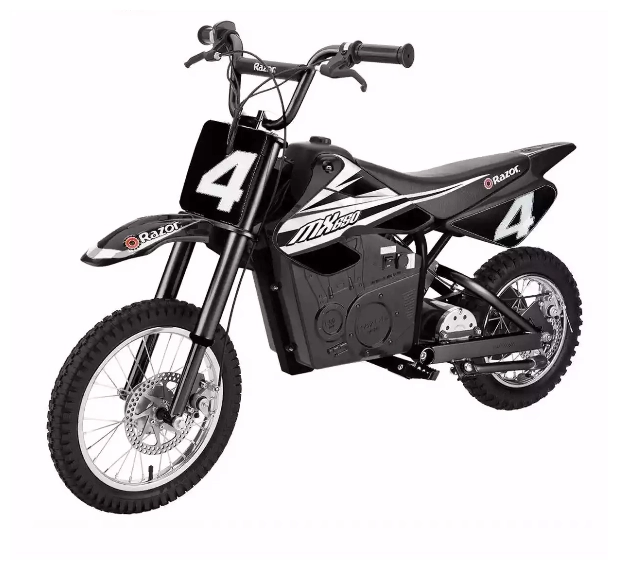
Razor MX650 Dirt Rocket
Ideal for teens looking for light off-road thrills, the Razor MX650 Dirt Rocket is priced under $900. It has dual-disc brakes, off-road tires, and a sturdy steel frame.
Its high-torque motor reaches speeds up to 17 mph with about 40 minutes of continuous use, making it a fun but manageable option.
Dual suspension adds comfort on bumpy trails, and the size fits younger or preteen riders well.
Pros: Durable, manageable speed, good for off-road fun
Cons: Shorter battery life and heavier frame
Pro Tip: Always check local laws about e-bike classes and speed limits for teens. Many areas restrict motor power and max speeds for young riders to keep them safe.
Finding the right e-bike means balancing safety, performance, and comfort—these top 5 models offer great options for teen riders in 2025. Ready to find the perfect e-bike and get your teen riding confidently?
How to Maintain an E-Bike for Teens
Taking good care of an e-bike keeps it running smoothly, safe, and ready for every ride. Teaching teens basic maintenance is not only smart—it builds responsibility and helps them enjoy their bike longer.
Basic Maintenance Tips for Longevity and Safety
- Keep the battery charged but avoid overcharging; unplug once full to protect battery health
- Check tire pressure regularly—properly inflated tires improve performance and reduce flats
- Clean the bike after rides, especially if it’s been wet or muddy, to prevent rust and wear
- Inspect brakes and cables often to make sure everything stops smoothly and safely
- Lubricate the chain occasionally to avoid squeaks and keep pedaling easy
Teaching Teens Responsible E-Bike Care
Encourage teens to:
- Do a quick safety check before each ride—tires, brakes, lights, and battery level
- Store the bike indoors or under cover to protect it from weather damage
- Report any strange noises or issues right away so small problems don’t become big ones
Recommended Maintenance Schedule
- Weekly: Tire pressure, brake function, and battery charge
- Monthly: Clean the bike thoroughly, inspect the drivetrain, and lubricate the chain
- Every 6 months: Take the bike for a professional tune-up to check motor and electrical components
Pro Tip: Make maintenance a fun routine by setting reminders or turning it into a quick weekend check-up with your teen. It keeps their e-bike in top shape and teaches great habits.
A well-maintained e-bike is safer, lasts longer, and delivers a better riding experience—perfect for teens who want to keep exploring. Ready to help your teen get the most out of their e-bike?
Safety Tips for Teen E-Bike Riders
Getting on an e-bike is exciting, but safety should always come first. Teaching teens good safety habits helps them enjoy every ride with confidence and peace of mind.
Wear Helmets and Protective Gear
The simplest way to stay safe is wearing a helmet every time you ride. It protects against head injuries and is often required by law for teen riders. Adding gloves, knee pads, and elbow pads can boost protection, especially on rougher terrain or busy streets.
Follow Riding Etiquette and Rules
Good habits keep everyone safe on the road and trails. Remind teens to:
- Always ride on the right side of the road or bike lane
- Use hand signals when turning or stopping
- Obey traffic lights and signs—e-bikes are vehicles too!
- Keep a safe distance from pedestrians and other cyclists
- Avoid distractions like headphones or phones while riding
Choose Safe Routes and Environments
Beginners should stick to quiet streets, bike paths, or parks with low traffic. This lets teens practice handling their e-bike without the stress of busy roads. Over time, they can build confidence and move on to more challenging routes safely.
Pro Tip: Practice riding with your teen in a safe, open area before heading out on public roads. It’s a fun way to build skills and discuss safety together.
Keeping safety front and center ensures teens have more fun and fewer worries. Ready to help your teen ride smart and safe? Find the perfect e-bike now!
Final Thoughts
Choosing the right e-bike for your teen means finding a balance between safety, affordability, and features that make riding fun and comfortable. A teen-friendly e-bike encourages confidence and independence while keeping safety front and center.
Involve your teen in the decision process—letting them test ride different models helps ensure the bike fits their style and needs. This way, they’re more excited to ride and more likely to care for their bike responsibly.
Pro Tip: Prioritize safety features like speed limits and reliable brakes, and always make sure your teen wears a helmet.
Ready to help your teen find the perfect e-bike? Explore the options, test a few models, and get them geared up for a safe, exciting ride!
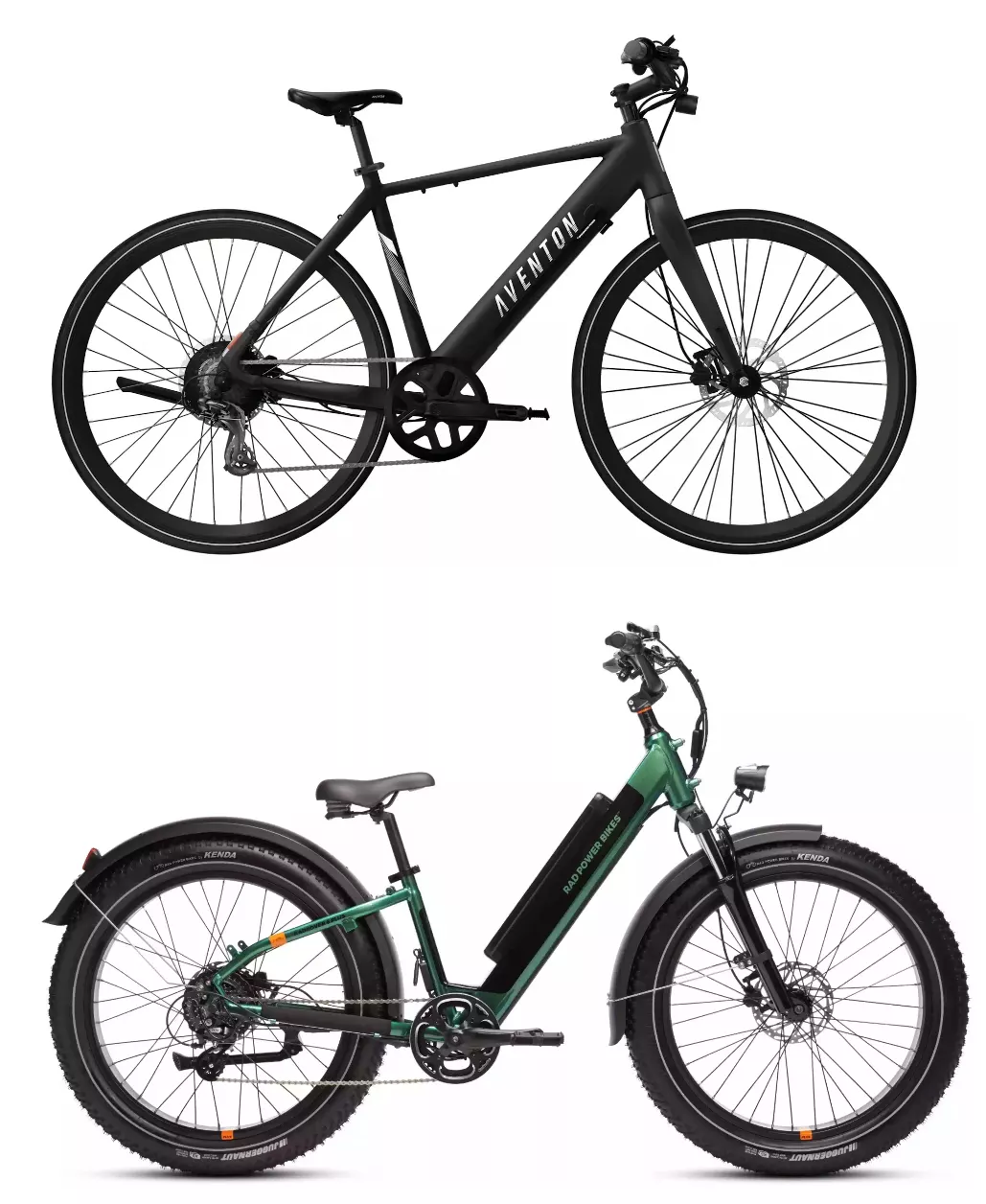
Thinking about buying an electric bike but not sure which brand to trust? You’re not alone. With so many options out there, narrowing it down to the right model can feel overwhelming—especially when two names keep popping up: Rad Power Bikes and Aventon.
These two brands are leading the charge in the e-bike world. Whether you're commuting to work, cruising the boardwalk, or replacing your car for errands, both offer solid choices. But how do they stack up against each other?
In this comparison guide, we’ll break down everything that matters—from ride quality and tech to pricing and support. By the end, you'll know exactly which brand suits your lifestyle and budget best.
Pro Tip: E-bikes qualify as green transportation in many cities—check if your area offers rebates or incentives for buying one!
Why Rad Power and Aventon Are Worth Comparing
Rad Power and Aventon are often mentioned in the same breath for a reason—they're both well-established, offer reliable bikes, and pack plenty of value. Here’s a quick snapshot of what makes each brand stand out:
Rad Power Bikes:
- Known for utility-first designs and rugged versatility
- Great for hauling, delivery, or all-weather commuting
- DIY-friendly with wide aftermarket support
Aventon:
- Sleek, modern frames built for comfort and performance
- App-connected tech and digital customization
- Strong lineup for commuters and urban riders
Both offer pedal assist and throttle modes, long-lasting batteries, and competitive warranties. But there are key differences in design philosophy, ride feel, and feature sets.
Pro Tip: When choosing an e-bike, always factor in where you’ll ride most—city streets, bike trails, or mixed terrain. It affects everything from tire size to battery life.
Brand Backgrounds
Rad Power Bikes
Rad Power Bikes was founded in 2015 with a clear mission: to make electric bikes accessible, practical, and fun for everyone. What started as a garage-built DIY project quickly grew into one of the most recognizable e-bike companies in North America.
Why riders love Rad:
- Utility-first design with models built for cargo, commuting, and even off-road use
- Affordable pricing that opens the door for first-time e-bike buyers
- Large community and support network, including replacement parts and how-to guides
They’re especially known for their tough, functional builds—think fat tires, rear racks, and a throttle for easy cruising. If you're looking for one of the best e-bikes for delivery work, family errands, or just getting around with gear, Rad Power is a top contender.
Pro Tip: Rad’s flagship models like the RadRunner and RadWagon offer impressive hauling capacity without needing a car replacement budget.
Aventon
Aventon launched in 2013 and originally made a name for itself in the fixed-gear bike scene before shifting focus to electric bikes. That design-first mindset is still obvious in their current e-bike lineup—sleek frames, smooth welds, and a premium feel without the premium price tag.
What sets Aventon apart:
- Modern styling with integrated batteries and hidden cabling
- Sporty, responsive ride quality that feels fast and agile
- App integration for tracking rides, adjusting settings, and checking battery life
Aventon’s models are some of the best electric bikes for urban commuting and recreational riding. They strike a balance between comfort and performance, which makes them a favorite for riders who want both function and flair.
Pro Tip: Many Aventon bikes come with torque sensors instead of cadence sensors, giving you a more natural-feeling pedal assist. It's a subtle upgrade, but one that experienced riders often appreciate.
Model Lineup Overview
Not all e-bikes are built the same—and that’s a good thing. Whether you want something for city commuting, hauling groceries, weekend trail rides, or folding up for apartment living, both Rad Power and Aventon offer solid options. Knowing which models match your lifestyle is key to finding the best electric bike for your needs.
Here’s a side-by-side look at how their top models compare:
| Type | Rad Power Bikes | Aventon |
| Commuter | RadCity 5 Plus | Level.2 |
| Cargo | RadWagon 4 | Abound |
| Folding | RadExpand 5 | Sinch.2 |
| Fat Tire | RadRover 6 Plus | Aventure.2 |
| Step-Thru | RadRunner Plus Step-Thru | Pace 500.3 Step-Through |
Both brands offer something for every kind of rider, but their designs serve different styles:
- Rad Power Bikes lean toward rugged practicality, with wide tires, integrated racks, and built-in utility.
- Aventon focuses on a more refined feel—sleek frames, stylish colors, and app-connected features.
If you’re unsure what type of e-bike is best for you, start by thinking about where you’ll ride most often and how much you plan to carry.
Pro Tip: Cargo and fat tire models are great if you need stability and extra power for heavier loads or bumpy terrain. For daily commuting, a lightweight city cruiser with a step-through frame makes hopping on and off easy.
Motor & Battery Performance
Power and range are two of the most important factors when choosing an electric bike. Whether you're tackling steep hills or trying to make it through your daily commute without a recharge, the motor and battery setup can make or break your ride. Rad Power and Aventon take slightly different approaches, and that affects both how their bikes feel and how far they’ll take you.
Motor Types & Power
Most Rad Power and Aventon models use rear hub motors, which are reliable, low-maintenance, and offer solid torque for everyday riding. Mid-drive motors, which provide a more balanced and efficient feel, aren’t offered by either brand at this time—though both brands still deliver strong performance with their hub setups.
Motor specs at a glance:
- Rad Power Bikes: 750W geared rear hub motors on most models
- Aventon: 500W or 750W hub motors depending on the model, with torque sensors for smoother power delivery
When it comes to acceleration and hill climbing, Rad’s motors tend to feel stronger right out of the gate, thanks to higher peak torque. Aventon, however, offers a more refined pedal assist experience, especially on newer models like the Aventure.2 and Level.2.
Throttle and pedal assist modes come standard on most models from both brands, letting you choose between effortless cruising or more interactive pedaling.
Pro Tip: If you ride in a hilly area or carry a lot of gear, Rad’s torquey motors may give you the edge. For riders who want a more natural cycling feel, Aventon’s pedal assist tuning is hard to beat.
Battery Range & Charging
Aventon and Rad Power both use lithium-ion batteries that balance power with reliability. But how far can they go on a single charge? That depends on a few things: motor power, rider weight, terrain, and how much you rely on throttle.
Battery details:
- Rad Power Bikes: 672Wh to 750Wh batteries, offering up to 45 miles on a single charge
- Aventon: 614Wh to 720Wh batteries, with ranges up to 60 miles depending on the model and assist level
Aventon often pulls ahead on range, especially with its efficient torque sensors that conserve battery power. Many of their batteries are also fully integrated into the frame, giving the bikes a clean, streamlined look.
Both brands offer removable batteries, which is a huge plus for apartment dwellers or anyone who wants to charge indoors. Charging typically takes 4–6 hours, and both companies offer replacement batteries if you need a backup or upgrade.
Pro Tip: Use lower pedal assist levels for longer rides. Level 1 or 2 can nearly double your range compared to full throttle or max assist.
In short: Rad Power gives you punchy power and utility-focused batteries. Aventon goes for range, smooth efficiency, and stylish integration. Choose based on how—and how far—you plan to ride.
Ride Quality & Comfort
A good e-bike isn’t just about speed and specs—it’s about how it feels on the road. Ride quality can make or break your daily commute or weekend cruise. Let’s see how Rad Power and Aventon stack up when it comes to comfort, stability, and overall riding experience.
Frame Geometry and Ergonomics
Both brands offer upright riding positions designed to reduce strain on your back, shoulders, and wrists. That said, Rad Power’s bikes tend to feel more like cruisers—wide handlebars, relaxed frames, and step-through options for easy mounting.
Aventon, on the other hand, leans toward a sportier feel, especially on models like the Aventure.2 and Level.2. These bikes place you in a slightly more forward-leaning posture that boosts aerodynamics and control, which is great for city riding.
What to expect:
- Rad Power: Comfortable, casual, and easy to handle
- Aventon: Agile, responsive, and designed for active pedaling
Pro Tip: If you have back or joint issues, Rad’s upright geometry and fat tires may provide a more forgiving ride.
Suspension, Tires & Seat Comfort
Most Rad and Aventon bikes come with front suspension forks to smooth out cracks, curbs, and light trails. You’ll feel a noticeable difference in comfort on bumpy roads, though neither brand offers full-suspension models (yet).
Key comfort features:
- Rad Power: Wider tires and plush saddles for cushy rides
- Aventon: Slightly firmer feel, with narrower tires on some commuter models
Rad’s fat tire bikes—like the RadRover—offer extra shock absorption and are ideal for mixed terrain. Aventon’s tires are more commuter-focused, providing efficient rolling and nimble handling on paved roads.
Stability, Noise & Handling
In terms of stability, Rad bikes feel grounded and sturdy, especially at slower speeds or with added cargo. Their heavier frames and fat tires provide a planted feel, perfect for new riders or anyone prioritizing control.
Aventon’s bikes feel lighter and quicker, making them more fun for weaving through traffic or zipping along bike lanes. Their motors are also noticeably quieter, giving Aventon the edge in the low-noise department.
Pro Tip: Planning to ride in busy city traffic? Aventon’s responsive handling and lightweight frame may give you more confidence when making quick turns or lane changes.
Best For: Commutes or Cruising?
If you're looking for the best e-bike for long commutes, Aventon’s efficient design, torque-sensing pedal assist, and lighter frame make it a strong choice. But for casual cruising, weekend rides, or utility hauling, Rad Power delivers comfort and stability that’s hard to beat.
Choosing the right ride really depends on what matters more: smooth power and nimble control, or comfort and all-terrain confidence.
Features & Tech
A great e-bike isn’t just about speed and range—it’s also about smart features that make every ride smoother, safer, and more enjoyable. Rad Power and Aventon both offer a solid lineup of built-in accessories and tech, but they take slightly different paths when it comes to connectivity and customization.
Built-In Accessories: Lights, Fenders & Racks
Both brands understand that e-bikes are often car replacements, so they include a lot of must-have gear right out of the box.
Standard features you’ll find on most models:
- Integrated front and rear lights for visibility and safety
- Full-coverage fenders to protect against rain and road spray
- Rear racks for cargo, bags, or child seats
Rad Power leans hard into utility. Their racks are beefy, modular, and ready for add-ons like baskets or panniers. Aventon’s setups are sleeker, blending into the frame design while still offering decent load capacity.
Pro Tip: If you plan to carry groceries, a backpack, or even a passenger, check weight limits for each bike’s rear rack—Rad usually has the upper hand.
Display & App Integration
Here’s where the two brands start to diverge. Aventon shines when it comes to connected tech, while Rad keeps things simple and straightforward.
Rad Power:
- LCD displays with basic info like speed, battery level, trip distance, and assist level
- No official app, though the display is easy to read and durable
Aventon:
- Color LCD displays with more detailed metrics
- Aventon app lets you track rides, share stats, and even customize your assist levels via Bluetooth
The Aventon app adds real value if you like data, navigation, or tweaking performance settings. It’s especially useful for riders who want to monitor their fitness or keep tabs on long-term battery performance.
Customization & Smart Features
Rad bikes are known for being DIY-friendly—it’s easy to add accessories, swap parts, or even do basic repairs yourself. The brand supports a huge ecosystem of compatible upgrades.
Aventon’s newer models focus on refined experiences over raw customization. With integrated electronics and frame design, they look cleaner but offer fewer options for heavy modification.
Highlights:
- Rad Power: Highly customizable, great for utility riders
- Aventon: App-connected and sleek, great for tech-forward commuters
Pro Tip: Want to personalize your ride? Rad’s open design gives you more flexibility. Prefer plug-and-play convenience? Aventon’s built-in tech wins for simplicity.
Whether you value smartphone integration or hands-on upgrades, both brands give you the tools to make your ride feel like yours.
Build Quality & Design
Looks matter—but so does durability. When investing in an e-bike, you want a ride that not only turns heads but also holds up over time. In this section, we’re comparing Rad Power and Aventon on materials, craftsmanship, and overall design philosophy.
Frame Material and Build Quality
Both brands use aluminum alloy frames, which strike a great balance between strength and weight. Rad Power Bikes are built with rugged durability in mind. You’ll find oversized tubing, reinforced welds, and extra attachment points for racks or baskets.
Aventon’s bikes feel more refined and precision-crafted. Their frames feature smooth welds (almost invisible on some models), and you can see the attention to detail in things like internal cable routing and tight panel gaps.
In short:
- Rad Power: Tough, utility-built frames built to handle real-world abuse
- Aventon: Polished, high-quality finishes that look and feel premium
Pro Tip: If you're planning to ride in all seasons or carry loads regularly, Rad’s build quality is hard to beat. For riders who prioritize form as much as function, Aventon’s clean frame work stands out.
Aesthetic Design and Finish
Aventon takes a clear lead when it comes to modern styling. Their bikes have a sleek, minimalist look, with color-matched components and low-profile battery integration. They’re often mistaken for high-end analog bikes, which is a big win if you want something stylish.
Rad Power’s designs are more function-first—chunky tires, built-in racks, and bolt-on batteries give off a more rugged, tool-like vibe. It’s not a bad thing, but it’s definitely a different look.
Style breakdown:
- Rad Power: Utility aesthetic, often industrial or bold
- Aventon: Streamlined, commuter-friendly, and polished
Weight and Portability
Electric bikes aren’t featherlight, but some are easier to manage than others. Most Rad Power models weigh between 65–75 lbs, due to their larger frames and utility features. That can make them tough to lift or carry upstairs.
Aventon bikes usually fall in the 50–60 lb range, depending on the model. Their sleeker design and integrated batteries shave off extra pounds, which makes a difference for urban riders or apartment dwellers.
Key takeaway:
- Rad Power: Heavier, but solid and balanced for stable riding
- Aventon: Lighter, easier to carry, and better for tight urban spaces
Pro Tip: If portability matters—like getting your bike into a car, up stairs, or onto public transit—Aventon’s lighter frames may save you daily frustration.
Whether you want a bike that’s built like a tank or one that blends in with urban traffic, both brands offer quality builds—it just comes down to your priorities.
Pricing & Value
Electric bikes come in a wide range of prices, but finding the sweet spot between cost and quality is key. Whether you're on a tight budget or willing to invest in premium features, both Rad Power and Aventon offer strong value—but in slightly different ways.
General Price Ranges
Rad Power Bikes typically range from $1,299 to $2,099, depending on the model and accessories included. Their pricing reflects a utility-focused build, with standard features like racks, lights, and wide tires baked in.
Aventon’s lineup falls between $1,199 and $1,999, with more variation based on tech features and design. They’re known for competitive pricing, especially considering the quality of their finishes and app-connected capabilities.
Quick comparison:
- Rad Power: Slightly higher average prices, more cargo-ready builds
- Aventon: Slightly lower base prices, tech-forward features included
Pro Tip: Always factor in what’s included—like racks, fenders, or integrated lights. A bike that looks cheaper may cost more once you add the extras.
Feature-to-Price Breakdown
Rad Power gives you a lot of practical features at every price point. You're getting a high-torque 750W motor, a rugged frame, and real-world accessories that make everyday use simple. These bikes are built to do more—especially if you’re replacing car trips.
Aventon balances performance and polish. Their torque sensors, color displays, and app integration feel high-end, even on mid-range models. You’re paying for ride quality and smart design, not just raw specs.
What each brand delivers per dollar:
- Rad Power: Best value for utility riders or anyone needing hauling power
- Aventon: Best value for urban riders and tech-savvy commuters
Best Value Picks from Each Brand
If you're trying to get the most bang for your buck, here are two standout models:
- RadRunner Plus (Rad Power): A versatile utility e-bike with passenger seating, integrated rear rack, and fat tires. Great for hauling kids, groceries, or gear—no upgrades needed.
- Aventon Level.2: A sleek commuter with a torque sensor, integrated lights, and hydraulic disc brakes. Perfect for daily rides, errands, and getting around town efficiently.
Pro Tip: Subscribe to each brand’s newsletter or check for seasonal sales—they often offer discounts, free shipping, or bonus accessories during peak times.
At the end of the day, both brands offer strong value—it just depends on how you ride and what features matter most to you.
Warranty & Customer Support
Buying an e-bike is a big investment, so it's important to know what kind of support you can expect after the sale. Rad Power and Aventon both offer warranty coverage and customer service, but their policies and reputations vary in a few key areas.
Warranty Coverage
Both brands provide standard one-year warranties on key components like the motor, battery, and electronics. However, some differences exist in how coverage is applied.
Rad Power Bikes:
- 1-year warranty on frame, battery, and electrical parts
- Optional RadCare extended warranty with accident protection
- Strong focus on DIY support for out-of-warranty repairs
Aventon:
- 1-year warranty on electronics and mechanical components
- 2-year warranty on the frame
- Some exclusions apply, especially for wear-and-tear items
Both brands cover manufacturing defects, but not damage from crashes or misuse.
Pro Tip: Keep your receipt and register your bike right after purchase to activate full warranty protection.
Return Policies and Trial Periods
Aventon and Rad Power both allow returns—but with conditions.
- Rad Power Bikes: 14-day return window from delivery; must be in like-new condition; $150 return shipping fee may apply
- Aventon: 14-day return window; bike must have under 10 miles and be in original packaging; return shipping not covered
Neither brand offers a long-term trial period like some premium bike companies, so make sure to take a few test rides early on if possible.
Customer Service & Reputation
Rad Power has built a large customer base and offers extensive documentation, including setup videos and repair guides. However, with their rapid growth, some users report slow email replies during peak seasons.
Aventon is known for quick response times and solid pre- and post-sale support. They also have a live chat feature on their site, which can be helpful for fast answers.
Community support matters too:
- Rad Power: Larger user community, active forums, and Facebook groups
- Aventon: Smaller but growing user base, active app and social media presence
Pro Tip: If you're the DIY type, Rad’s extensive how-to resources and online community may give you a more self-reliant experience.
Both brands stand behind their bikes, but Aventon has a slight edge in direct support and longer frame warranty, while Rad makes up for it with better community resources and repair tutorials.
Assembly & Maintenance
An e-bike should make life easier—not more complicated. From unboxing to long-term upkeep, Rad Power and Aventon take different approaches to assembly, parts support, and ease of maintenance. Here’s what to expect from each brand when it comes to keeping your ride rolling.
Ease of Out-of-Box Setup
Both Rad Power and Aventon ship their bikes partially assembled, so you’ll need to attach things like the handlebars, pedals, front wheel, and sometimes the front fender.
Rad Power:
- Offers step-by-step video guides and detailed written instructions
- Many users can complete setup in about 45–60 minutes with basic tools
- Optional Rad Mobile Service (in select areas) for professional delivery and assembly
Aventon:
- Provides clear setup instructions and tools
- Slightly faster to assemble due to lighter frames and more integrated components
- No in-home service, but most shops familiar with Aventon bikes
Pro Tip: Even if you’re handy, consider a local bike shop for your first tune-up. Assembly errors can lead to early wear or safety issues.
Maintenance Accessibility
Rad Power is known for its DIY-friendly design. Their bikes use standard components and are easy to work on with basic tools, which is a big plus if you like doing your own maintenance.
Aventon uses more integrated components, especially on newer models. While this gives a cleaner look and fewer exposed cables, it can make certain repairs—like replacing a display or internal cable—more involved.
Maintenance overview:
- Rad Power: Easier for DIY repairs, wide compatibility with standard parts
- Aventon: Lower day-to-day maintenance but might require shop visits for tech-related issues
Parts Availability & Compatibility
Both companies sell replacement parts directly from their websites. Rad Power also has a broader aftermarket ecosystem, with many third-party parts and accessories compatible across its lineup.
Aventon has improved parts availability in recent years, but because of their sleek, proprietary frame designs, some components must be brand-specific—like display units, batteries, and frame-integrated lights.
Support breakdown:
- Rad Power: More modular and open, easy to upgrade or replace parts
- Aventon: Tighter integration, fewer third-party options but growing support
Pro Tip: For long-term ownership, Rad’s DIY approach may save you time and money. If you prefer a “set it and forget it” style, Aventon’s integrated design keeps things tidy and efficient.
Whether you’re a home mechanic or just want a reliable ride with minimal fuss, both brands have solid support systems—you just need to match the bike to your maintenance style.
User Reviews & Reputation
When it comes to choosing the best e-bike brand, real-world feedback is one of the most valuable resources you can tap into. What are other riders saying about their Aventon or Rad Power experience? Let’s take a look at overall sentiment, praise, and common complaints across review platforms and online communities.
Customer Sentiment & Community Buzz
Both Rad Power and Aventon have strong, passionate followings—and for good reason. Their e-bikes consistently earn praise for performance, design, and value. But there are also a few recurring themes that show up in forums and reviews.
Rad Power Bikes:
- Widely praised for practical design and ease of use
- Positive feedback on powerful motors and cargo-hauling ability
- Some complaints about shipping delays, especially during peak seasons
- Known issues: battery replacement costs and customer service response times
Aventon:
- Loved for sleek styling and smooth ride feel (especially newer torque-sensor models)
- High marks for the Aventon app and build quality
- A few users report app glitches or limited phone compatibility
- Some mention stiffer ride on models with narrow tires
Pro Tip: Searching Reddit threads or Facebook e-bike groups can give you honest, unfiltered opinions from current owners. Look for reviews that span 6–12 months of ownership to see how bikes hold up long-term.
Review Platforms & Influencer Opinions
Trustpilot Ratings (as of latest public data):
- Rad Power Bikes: ~4.1 stars
- Aventon: ~4.3 stars
On YouTube, influencers regularly test and review both brands, with Rad bikes often praised for raw utility and Aventon for their refined experience and tech-forward features.
Top creators like Electrek, The Inja, and Freshly Charged have favorably reviewed both brands, with Aventon standing out for ride quality and Rad for value per watt.
Common influencer verdicts:
- Rad Power: Great for first-time buyers and those who need cargo-ready performance
- Aventon: Excellent choice for commuters who want style, range, and app-based tuning
Final Reputation Takeaways
Both Aventon and Rad Power have earned their place at the top of the e-bike market. The biggest differences come down to user priorities: Rad’s loyal fan base loves its rugged, do-it-all practicality, while Aventon appeals to riders who value modern design, smoother rides, and integrated tech.
Whichever brand you choose, you’ll be joining a large, vocal community that can help you get the most from your e-bike.
Best For… (Quick Match Guide)
Still unsure which e-bike brand is right for you? Here’s a quick match guide to help you decide based on your lifestyle, riding habits, and personal preferences. Whether you’re hauling groceries or zipping through downtown traffic, one of these brands likely fits you better.
Rad Power is Better For:
Rad Power Bikes are built for versatility and practicality. If you're looking for maximum utility and comfort at a competitive price, Rad is hard to beat.
Choose Rad Power if you:
- Need a bike for cargo hauling, errands, or carrying passengers
- Want a budget-friendly e-bike that includes useful accessories out of the box
- Prefer DIY-friendly maintenance and easy customization
- Ride casually or commute shorter distances at a relaxed pace
- Live in areas with wider bike lanes or mixed terrain
Pro Tip: Rad’s models like the RadRunner and RadWagon are perfect for replacing short car trips or running daily errands.
Aventon is Better For:
Aventon brings modern styling and smooth performance to the table. Their bikes are ideal for riders who value design, ride feel, and connectivity.
Choose Aventon if you:
- Want a sleek commuter e-bike with integrated tech
- Ride in urban environments with lots of stop-and-go traffic
- Care about aesthetics and seamless design
- Appreciate smart features like app control and torque sensors
- Prefer a lighter, more nimble frame for easy handling
Pro Tip: If you're buying your first e-bike and want something stylish and intuitive, Aventon’s Level.2 or Soltera.2 are great starter picks.
Both brands deliver strong performance, but their strengths serve slightly different riders. Focus on how and where you'll ride most often—and let that guide your final choice.
Final Verdict
Rad Power and Aventon are two of the most trusted names in the electric bike world—but which one is right for you? The answer depends on what you value most: power and utility, or style and smart tech?
Key Differences Recap
Here’s how these two brands stack up across core categories:
- Rad Power leads in cargo capability, value, and DIY maintenance
- Aventon wins on ride quality, design, and tech features
- Both offer reliable motors, good warranties, and a wide model selection
- Rad bikes tend to be heavier and more rugged, while Aventon bikes are lighter and sleeker
Pro Tip: Use your daily needs as the deciding factor. Do you haul gear or commute daily? Do you value comfort or app integration more?
Which Brand Stands Out?
- If you’re looking for the best e-bike for hauling, family rides, or running errands, Rad Power is your go-to.
- If you want the best electric bike for urban commuting, with a smoother feel and smarter tech, Aventon is likely the better match.
Final Recommendations
Choose Rad Power if you:
- Want a workhorse bike for hauling, long rides, or weekend adventures
- Like the idea of customizing and upgrading your ride over time
- Prioritize rugged performance and out-of-the-box utility
Choose Aventon if you:
- Prefer sleek design, smooth power delivery, and smart features
- Plan to ride mostly in cities or on paved bike paths
- Want a refined experience with minimal maintenance
Both brands offer excellent value and quality. The right choice just comes down to how you ride and what features matter most to you. Ready to roll? Find the perfect e-bike and hit the road in style.
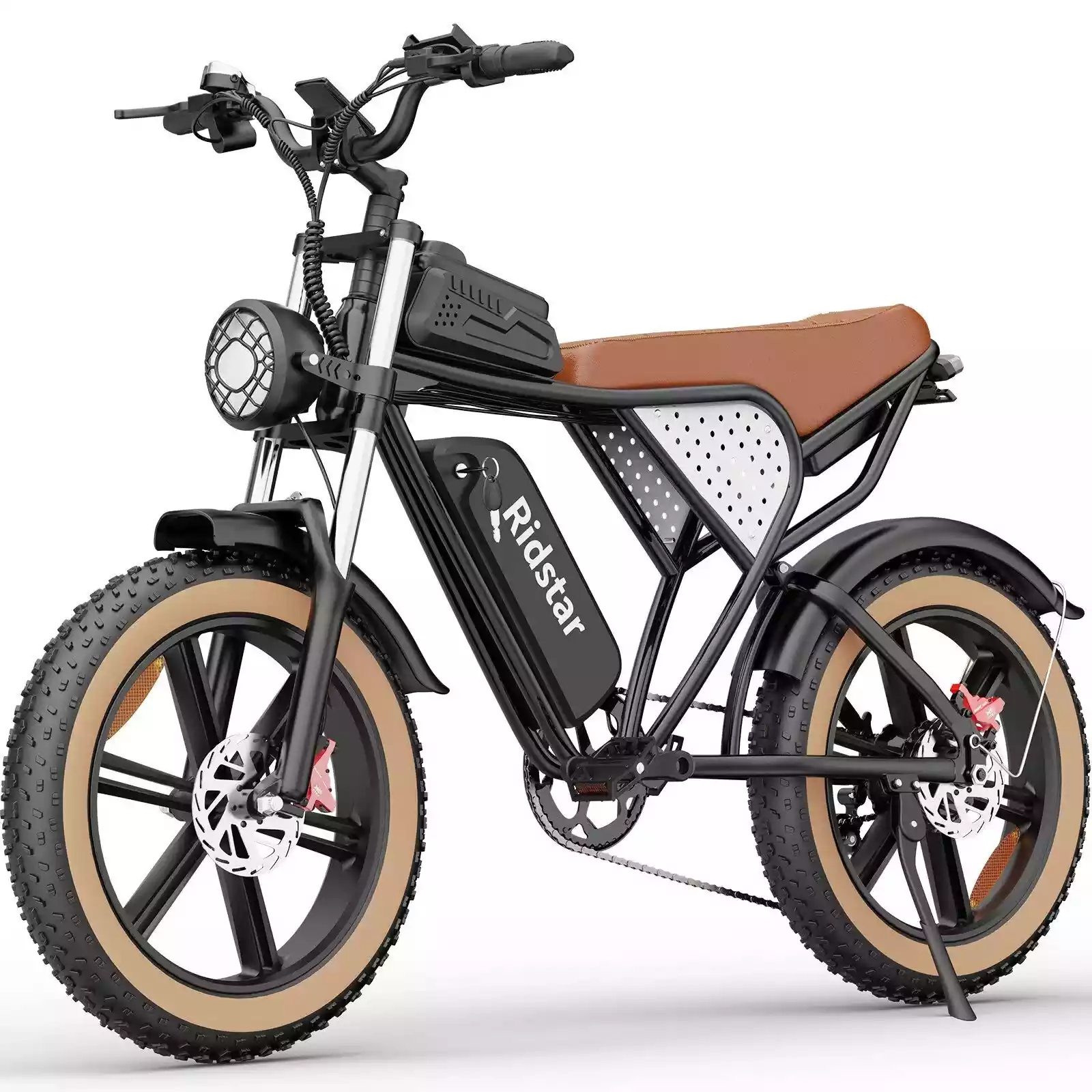
Thinking about buying an electric bike but confused by all the “Class 1, Class 2, Class 3” talk? You’re not alone. Understanding how e-bikes are categorized is a key part of choosing the right one—especially if you want to stay within the law and ride where you want.
In this guide, we’ll break down the three main e-bike classes in plain English. You'll learn how they differ in speed, throttle features, and legal access—plus which class might be best for your lifestyle. Whether you're commuting, cruising, or just getting started, this quick breakdown will point you in the right direction.
Why E-Bike Classes Matter
E-bikes are more popular than ever. They're fast, fun, eco-friendly, and perfect for beating traffic or exploring your city. But not all e-bikes are created equal—and understanding the class system is essential before you buy.
Here’s why the class matters:
- Legal Access: Some bike paths, parks, and public trails only allow certain classes.
- Top Speeds: Each class comes with its own speed limits, which affect how and where you can ride.
- Throttle vs. Pedal Assist: The type of motor control changes the entire riding experience.
Pro Tip: Many cities and states follow the same 3-class system, but local laws can vary. Always double-check your area's regulations before hitting the road.
Up next: Let’s dive into exactly what makes a Class 1, Class 2, or Class 3 e-bike unique—so you can ride smarter and buy with confidence.
What Are E-Bike Classes?
If you're diving into the world of e-bikes, one of the first things you'll notice is that not all electric bikes are the same. In fact, they’re grouped into three official “classes”—and knowing the difference can make or break your riding experience.
The e-bike class system was first introduced in California and has since been adopted in many other states. It’s designed to give structure to how electric bikes are regulated and where they’re allowed to go.
How E-Bikes Are Classified
The class of an e-bike is based on three main things:
- How the motor activates (pedal-assist only or throttle-enabled)
- Top speed while using motor assistance
- Whether or not it includes a throttle
These factors don’t just affect how your ride feels—they determine where you can legally ride. For example, some bike trails or city paths allow only Class 1 e-bikes because they behave more like traditional bicycles.
Pro Tip: If you plan to ride on multi-use trails or through parks, check what classes are permitted before you invest in a bike.
Understanding e-bike classes helps you match your ride to your lifestyle, avoid fines, and get the most from your purchase. Keep reading to explore each class and find the best e-bike for your needs.
Class 1 E-Bikes: Pedal Assist Only
Want an e-bike that feels like a traditional bike, just with an extra push when you need it? A Class 1 e-bike might be your perfect match. It’s the most widely accepted and beginner-friendly option on the market.
What Makes a Class 1 E-Bike?
Class 1 e-bikes offer pedal assist only—meaning the motor kicks in only when you’re pedaling. There’s no throttle, so you won’t be able to cruise without putting in some effort.
Here’s what defines a Class 1:
- Motor Activation: Pedal-assist only (no throttle)
- Top Speed: 20 mph with assistance
- Motor Limit: Up to 750 watts
- Legal Use: Allowed on most city bike lanes, greenways, and off-road trails
Best For:
- Commuters who want reliable, sweat-free rides without relying on a car
- Fitness riders looking for a boost on hills or long-distance routes
- Cyclists who still want a natural pedaling experience with added support
Pro Tip: Class 1 e-bikes are your best bet if you want access to the most bike-friendly areas, including shared-use trails and park paths.
Pros of Class 1 E-Bikes
- Widely accepted on bike paths, trails, and in most cities
- Lightweight and simple—no throttle means fewer controls to manage
- Encourages physical activity while still giving you a boost
Cons to Consider
- No throttle, so you can’t coast or get started without pedaling
- May not be ideal for riders with mobility issues or those who want full motor control
If you're looking for the best e-bike for commuting, fitness, or casual riding, Class 1 models are a solid choice—especially if you're just getting started. Keep reading to see how they compare to Class 2 and Class 3 bikes.
Class 2 E-Bikes: Throttle + Pedal Assist
Want the freedom to ride without pedaling at all? Class 2 e-bikes give you the best of both worlds: full pedal assist and a throttle that lets you cruise with zero effort.
This class is perfect for riders who want control, comfort, and convenience—especially when starting from a stop or navigating hills.
What Makes a Class 2 E-Bike?
Class 2 e-bikes are equipped with both pedal assist and a throttle, meaning you can ride with motor power even if you’re not pedaling. Just twist or press the throttle, and the bike moves—easy as that.
Here’s what defines a Class 2:
- Motor Activation: Pedal-assist and throttle
- Top Speed: 20 mph (on both throttle and assist)
- Motor Limit: Up to 750 watts
- Legal Use: Allowed in many areas, but sometimes restricted on bike-only trails or nature paths
Best For:
- Riders with mobility or joint issues who need a more accessible ride
- Casual riders and cruisers who value comfort and ease
- City commuters who want quick starts at traffic lights or uphill boosts
Pro Tip: Throttle control is great for stop-and-go traffic or tight turns where balancing while pedaling is tough.
Pros of Class 2 E-Bikes
- No need to pedal—just use the throttle to get moving
- Great for beginners, seniors, or riders recovering from injury
- Versatile: switch between throttle-only and pedal assist as needed
Cons to Consider
- May face more restrictions on trails and multi-use paths
- Slightly heavier and more complex due to added throttle system
If you're looking for one of the best e-bikes for comfort, casual rides, or urban commuting, Class 2 could be the perfect fit. Just be sure to check your local trail rules if you're planning to go off-road. Up next: Class 3, the fastest option of them all.
Class 3 E-Bikes: Fastest Pedal Assist
Need to keep up with city traffic or cover serious ground on your commute? Class 3 e-bikes are built for speed, making them a top choice for experienced riders and long-distance commuters.
Unlike Class 2, Class 3 bikes don’t include a throttle—but what they lack in throttle control, they make up for in top-end speed and power.
What Makes a Class 3 E-Bike?
Class 3 e-bikes offer pedal assist only, with no throttle, but they can reach up to 28 mph while you're pedaling. This class is designed for fast, efficient travel—especially on streets and bike lanes alongside cars.
Here’s what defines a Class 3:
- Motor Activation: Pedal-assist only (no throttle)
- Top Speed: 28 mph with assistance
- Motor Limit: Up to 750 watts
- Legal Use: Often restricted from bike paths and off-road trails; usually limited to roadways and dedicated bike lanes
Best For:
- Speed-focused commuters who ride in busy urban environments
- Experienced cyclists who want more power for longer, faster rides
- Riders with long commutes or who need to arrive quickly and sweat-free
Pro Tip: Many states require helmets for all Class 3 riders, regardless of age. Some also restrict Class 3 use to adults only.
Pros of Class 3 E-Bikes
- Fast and efficient—ideal for keeping pace with cars in city traffic
- Great for long-distance rides or high-speed commutes
- Can reduce car dependency for serious daily travel
Cons to Consider
- Not allowed on most bike paths, nature trails, or multi-use lanes
- Helmet use is often required by law, even for adults
- No throttle, so you must keep pedaling for motor support
If you're looking for one of the best e-bikes for fast commuting or road riding, Class 3 models deliver serious performance. Just be sure you’re okay sticking to streets and bike lanes—and always check your local laws before you ride.
Side-by-Side Comparison: Class 1 vs Class 2 vs Class 3 E-Bikes
Still deciding which e-bike class is right for you? This quick side-by-side comparison makes it easy to see how each class stacks up in terms of speed, features, and legal access.
Whether you're browsing the best e-bikes for commuting or looking for a simple pedal-assist model, this chart can help guide your decision.
| Feature | Class 1 | Class 2 | Class 3 |
|---|---|---|---|
| Pedal Assist | ✅ Yes | ✅ Yes | ✅ Yes |
| Throttle | ❌ No | ✅ Yes | ❌ No |
| Max Assisted Speed | 20 mph | 20 mph | 28 mph |
| Motor Power Limit | Up to 750W | Up to 750W | Up to 750W |
| Legal Trail Access | Allowed on most bike paths | Limited in some areas | Restricted from most trails |
| Ideal Use Case | Fitness, commuting, casual | Mobility, relaxed rides, urban | Fast commuting, road riding |
Pro Tip: If you’re planning to ride on public trails or in parks, Class 1 e-bikes are usually your safest bet when it comes to access.
This side-by-side view is especially useful if you're building a short list of options for your next ride. Keep it handy as you explore different models, compare features, and read electric bike reviews. Ready to pick your perfect ride? Keep reading for legal tips and real-world riding advice.
Legal and Safety Considerations for E-Bike Riders
Before you hit the road, there’s one more thing to think about—laws and safety rules. Each e-bike class comes with its own set of legal guidelines, and they can vary depending on where you live. Knowing the rules keeps you safe, and keeps your ride street-legal.
What to Know About E-Bike Laws
While the 3-class system is widely adopted across the U.S., state and local rules may still differ. Some areas are stricter than others, especially when it comes to speed, trail access, or throttle use.
Here are some key things to check in your area:
- Helmet Requirements:
- Most states recommend helmets for all riders
- Class 3 e-bikes often require helmets by law, even for adults
- Age Restrictions:
- Many places restrict Class 3 e-bikes to riders 16+
- Class 1 and 2 are more relaxed but may still have age minimums
- License or Insurance Needs:
- Not usually required, but a few localities may ask for registration or insurance for Class 3 bikes
- Always worth confirming with your local DMV or city website
Pro Tip: Call your local bike shop or transportation department if you’re unsure. They’ll know your city’s current e-bike rules better than anyone.
Why It Matters
Knowing the law helps you choose the right bike and ride it legally. It also helps you avoid tickets or conflicts on trails and streets.
For anyone using an e-bike for commuting, fitness, or fun, a quick legal checkup is a smart step before you buy. Better to be informed now than surprised later.
Next, we’ll help you figure out which class is the best fit for your lifestyle.
Which Class Is Right for You?
Now that you know how each e-bike class works, it’s time to choose the one that fits your lifestyle. Whether you're commuting, cruising, or getting back into riding, there's an electric bike class that matches your goals.
Quick Decision Guide
Here’s a fast way to narrow it down:
- Want to ride almost anywhere and get exercise? → Go with a Class 1
- Prefer a throttle and an easier ride? → Try a Class 2
- Need top speed for daily commutes? → Consider a Class 3
Each class serves a different type of rider, so think about how you plan to use your e-bike day to day.
Ask Yourself These Questions
Choosing the right class starts with understanding your own needs. Here are a few smart questions to ask:
- Where will I ride most?
If your favorite trails or parks restrict certain classes, Class 1 is your safest bet. - Do I want throttle control?
If starting from a stop is tough or you want a break from pedaling, a Class 2 might be your best option. - Is top speed important to me?
If you’re riding in traffic or commuting long distances, Class 3 offers the performance you need.
Pro Tip: Try test riding different classes before making a decision. Many local e-bike shops offer demos, and nothing beats feeling the difference yourself.
Choosing the right class will make your ride smoother, safer, and more enjoyable. Keep reading for some final thoughts and tips to make your first e-bike purchase a success.
Future Trends & Technology in E-Bikes
The e-bike world is evolving fast—and the future is looking smarter, faster, and more connected. As more riders hit the road, technology and laws are racing to keep up. Here's a look at what’s coming next in electric biking.
Evolving Laws and Class Definitions
As e-bike popularity grows, regulations are constantly being updated. Cities and states are refining where and how different classes can be used. We may see new sub-classes, new helmet rules, and more clarity around shared path access.
- Expect more local laws tailored to e-bike traffic and safety
- Some areas may introduce speed-sensitive zones using GPS tech
- Class standards could shift as new motor types hit the market
Pro Tip: Keep an eye on local transportation news—new rules can impact where you’re allowed to ride and what gear you need.
Tech That’s Changing the Ride
Modern e-bikes are quickly becoming more than just bikes with motors. Here's what’s shaking up the industry:
- Programmable speed limits: Some e-bikes can be adjusted for different ride zones or user types
- Smart displays and apps: Track battery life, navigation, ride stats, and even theft protection from your phone
- Integrated GPS: Great for route planning, commuting, or keeping tabs on your bike’s location
- Ride customization: Apps that let you control motor responsiveness, assist levels, and eco/sport modes
These upgrades not only improve performance but also make e-bikes feel more personal and connected—just like a modern electric car.
From high-tech gadgets to shifting policies, the future of e-biking is full of possibilities. Thinking long term? Choose a model with firmware updates or app support so your ride keeps getting better with time.
Find the Right E-Bike Class for Your Ride
Now that you know how Class 1, Class 2, and Class 3 e-bikes differ, choosing the right one should feel a lot easier. Each class offers a unique riding experience, and the best fit depends on your goals, habits, and where you’ll be riding.
Here’s a quick recap:
- Class 1: Pedal assist only, up to 20 mph — great for trails, fitness, and casual commuting
- Class 2: Pedal assist + throttle, up to 20 mph — ideal for comfort, mobility, and urban riding
- Class 3: Pedal assist only, up to 28 mph — best for fast commutes and road riders
Pro Tip: Laws vary widely by city and state, so always double-check local rules before buying or riding.
No matter which class you choose, the most important thing is to match your e-bike to your lifestyle, needs, and riding environment. If you’re still unsure, visit a local e-bike shop, take a few test rides, and ask questions. E-bike communities and online reviews are also great resources.
Ready to ride? Explore your options, stay informed, and choose a bike that makes every trip exciting. The right class can turn your daily commute or weekend adventure into the best part of your day.
Additional Resources for E-Bike Riders
Whether you're a new rider or upgrading to a faster class, having the right tools and knowledge makes every ride smoother and safer. Below are some helpful resources to explore as you continue your e-bike journey.
Stay Legal and Informed
- State-by-State E-Bike Law Guide – Check regulations for e-bike classes, helmet rules, and trail access in your area
- [Local Department of Transportation] – Great for updates on bike lanes, local rules, and commuting policies
Gear Up for Safety
- Recommended Safety Gear:
- Helmet with MIPS protection
- Rearview mirror for urban and high-speed riding
- Front and rear lights for visibility day or night
- Reflective clothing or decals for added safety
Pro Tip: Many Class 3 riders add mirrors and upgraded brakes for extra control at higher speeds.
Buying and Riding Guides
- [Beginner’s E-Bike Buying Guide] – Learn what to look for when choosing your first electric bike
- [E-Bike Fit & Comfort Tips] – Adjust your seat, bars, and pedal assist levels for the smoothest ride
- [Electric Bike Reviews (20XX)] – Find top-rated e-bikes by class, budget, and riding style
Find Places to Ride
- TrailLink – Discover paved bike trails, greenways, and commuter paths across the U.S.
- AllTrails – Great for finding multi-use paths and rating trails by surface type and terrain
- Local bike coalitions or clubs often publish community maps with e-bike-friendly routes
From legal know-how to gear and local trails, these resources help you make smart, confident choices—whether you’re riding for fun, fitness, or the daily commute.
